Impact of Lecture Attendance on Academic Results: A Descriptive Investigation
VerifiedAdded on 2023/06/15
|23
|2994
|322
AI Summary
This study investigates the impact of lecture attendance on academic results through a descriptive investigation. It includes the distribution of enrolled courses, opinions of students, reasons for not attending lectures, and the impact of lecture attendance on achieving academic results.
Contribute Materials
Your contribution can guide someone’s learning journey. Share your
documents today.
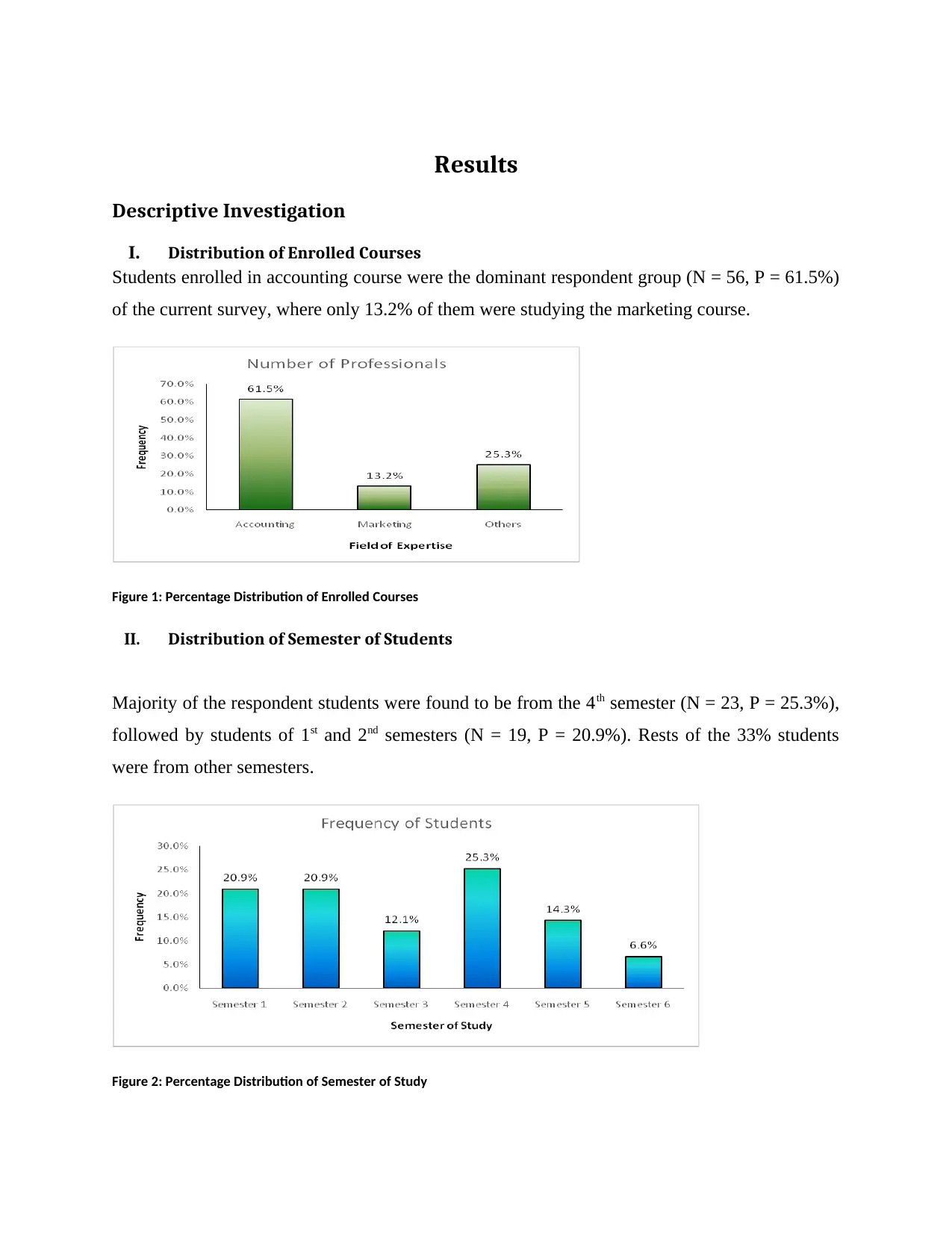
Results
Descriptive Investigation
I. Distribution of Enrolled Courses
Students enrolled in accounting course were the dominant respondent group (N = 56, P = 61.5%)
of the current survey, where only 13.2% of them were studying the marketing course.
Figure 1: Percentage Distribution of Enrolled Courses
II. Distribution of Semester of Students
Majority of the respondent students were found to be from the 4th semester (N = 23, P = 25.3%),
followed by students of 1st and 2nd semesters (N = 19, P = 20.9%). Rests of the 33% students
were from other semesters.
Figure 2: Percentage Distribution of Semester of Study
Descriptive Investigation
I. Distribution of Enrolled Courses
Students enrolled in accounting course were the dominant respondent group (N = 56, P = 61.5%)
of the current survey, where only 13.2% of them were studying the marketing course.
Figure 1: Percentage Distribution of Enrolled Courses
II. Distribution of Semester of Students
Majority of the respondent students were found to be from the 4th semester (N = 23, P = 25.3%),
followed by students of 1st and 2nd semesters (N = 19, P = 20.9%). Rests of the 33% students
were from other semesters.
Figure 2: Percentage Distribution of Semester of Study
Secure Best Marks with AI Grader
Need help grading? Try our AI Grader for instant feedback on your assignments.
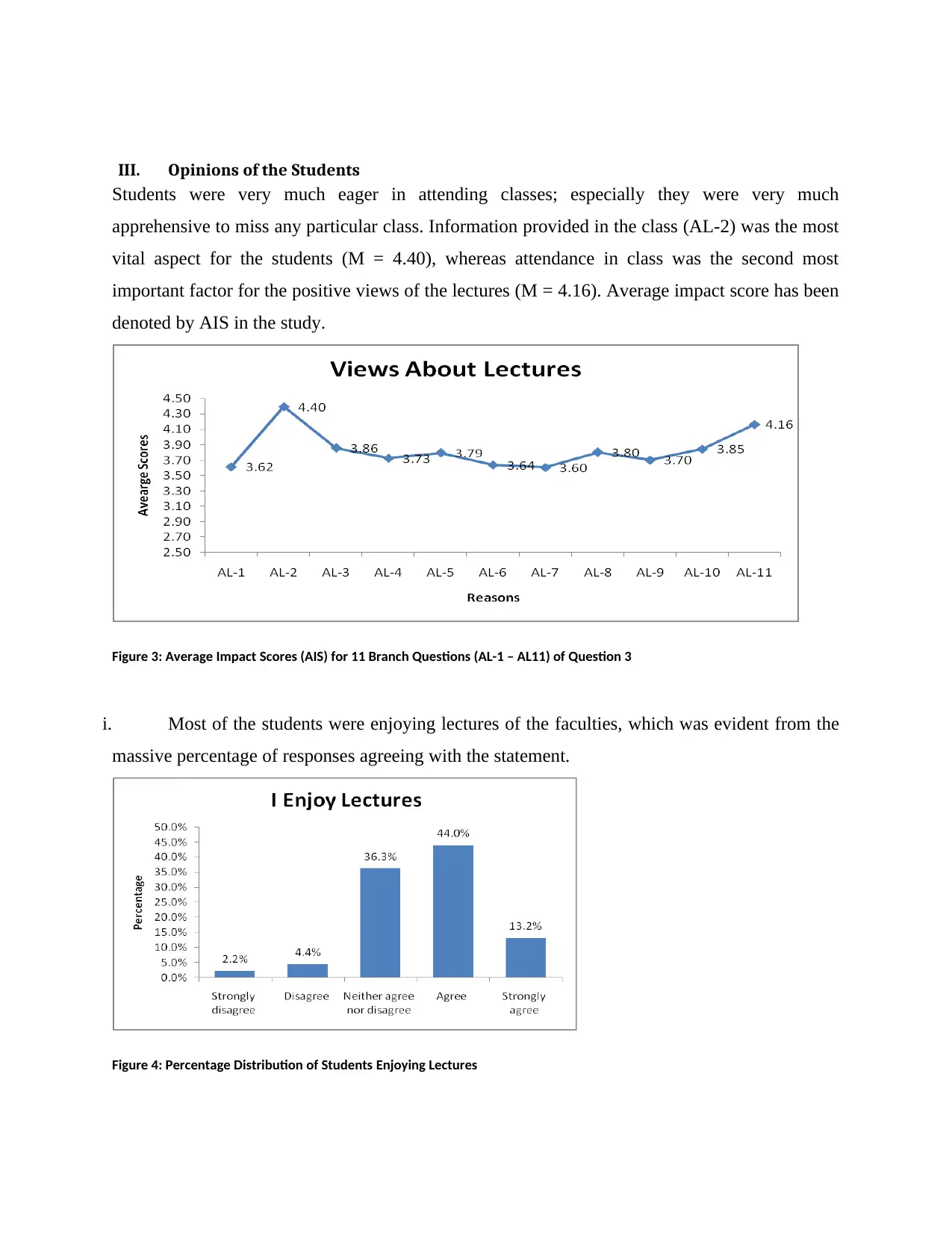
III. Opinions of the Students
Students were very much eager in attending classes; especially they were very much
apprehensive to miss any particular class. Information provided in the class (AL-2) was the most
vital aspect for the students (M = 4.40), whereas attendance in class was the second most
important factor for the positive views of the lectures (M = 4.16). Average impact score has been
denoted by AIS in the study.
Figure 3: Average Impact Scores (AIS) for 11 Branch Questions (AL-1 – AL11) of Question 3
i. Most of the students were enjoying lectures of the faculties, which was evident from the
massive percentage of responses agreeing with the statement.
Figure 4: Percentage Distribution of Students Enjoying Lectures
Students were very much eager in attending classes; especially they were very much
apprehensive to miss any particular class. Information provided in the class (AL-2) was the most
vital aspect for the students (M = 4.40), whereas attendance in class was the second most
important factor for the positive views of the lectures (M = 4.16). Average impact score has been
denoted by AIS in the study.
Figure 3: Average Impact Scores (AIS) for 11 Branch Questions (AL-1 – AL11) of Question 3
i. Most of the students were enjoying lectures of the faculties, which was evident from the
massive percentage of responses agreeing with the statement.
Figure 4: Percentage Distribution of Students Enjoying Lectures
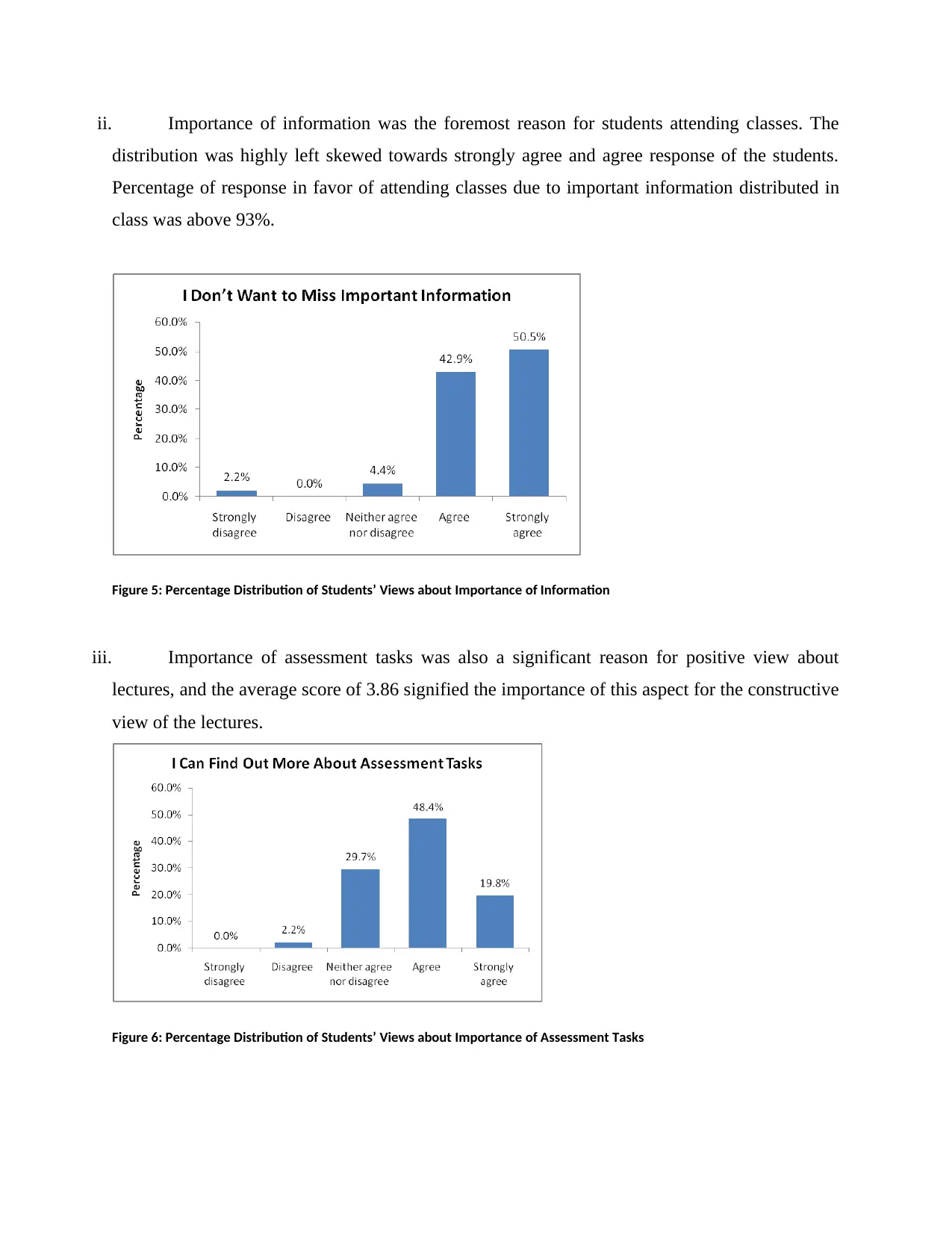
ii. Importance of information was the foremost reason for students attending classes. The
distribution was highly left skewed towards strongly agree and agree response of the students.
Percentage of response in favor of attending classes due to important information distributed in
class was above 93%.
Figure 5: Percentage Distribution of Students’ Views about Importance of Information
iii. Importance of assessment tasks was also a significant reason for positive view about
lectures, and the average score of 3.86 signified the importance of this aspect for the constructive
view of the lectures.
Figure 6: Percentage Distribution of Students’ Views about Importance of Assessment Tasks
distribution was highly left skewed towards strongly agree and agree response of the students.
Percentage of response in favor of attending classes due to important information distributed in
class was above 93%.
Figure 5: Percentage Distribution of Students’ Views about Importance of Information
iii. Importance of assessment tasks was also a significant reason for positive view about
lectures, and the average score of 3.86 signified the importance of this aspect for the constructive
view of the lectures.
Figure 6: Percentage Distribution of Students’ Views about Importance of Assessment Tasks
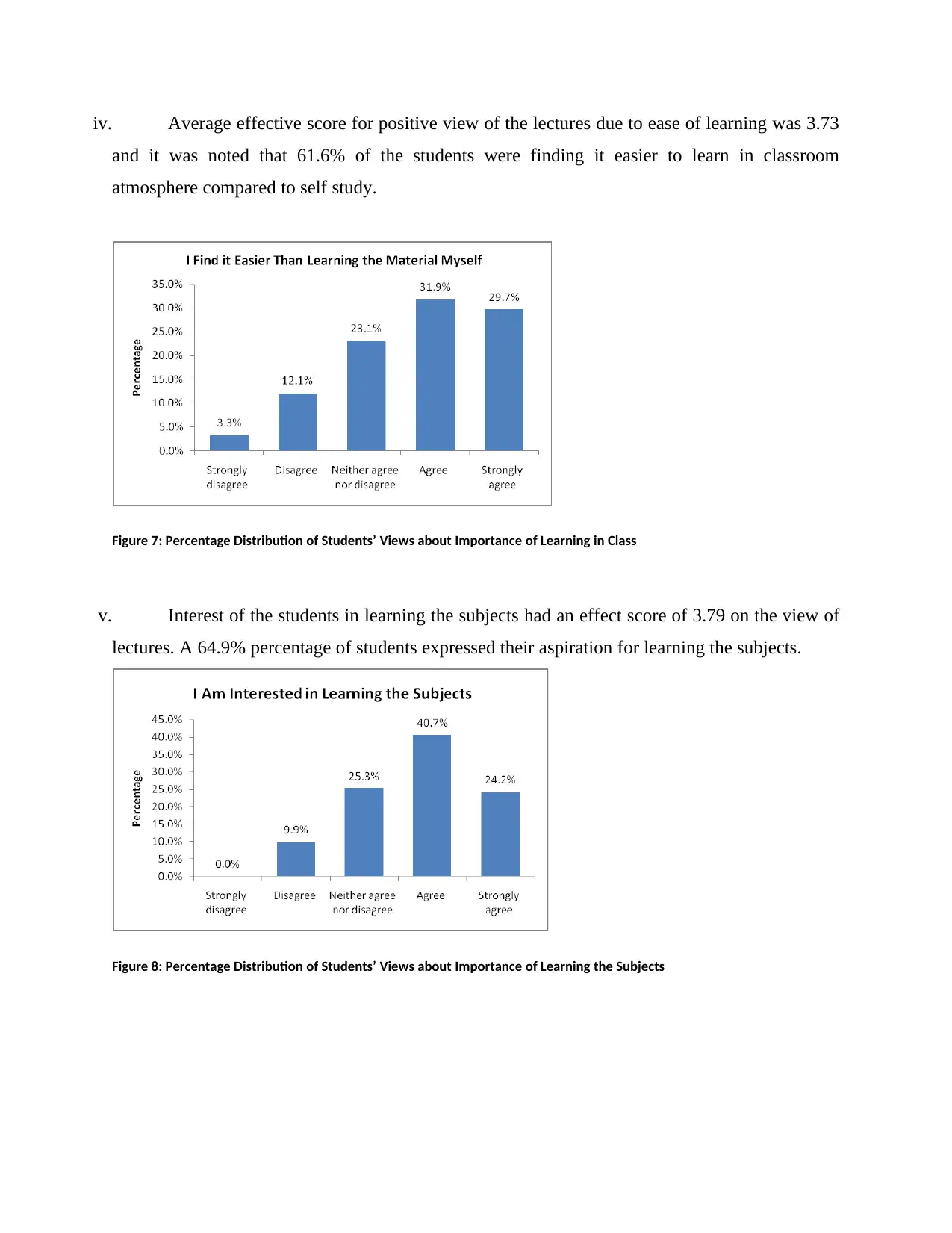
iv. Average effective score for positive view of the lectures due to ease of learning was 3.73
and it was noted that 61.6% of the students were finding it easier to learn in classroom
atmosphere compared to self study.
Figure 7: Percentage Distribution of Students’ Views about Importance of Learning in Class
v. Interest of the students in learning the subjects had an effect score of 3.79 on the view of
lectures. A 64.9% percentage of students expressed their aspiration for learning the subjects.
Figure 8: Percentage Distribution of Students’ Views about Importance of Learning the Subjects
and it was noted that 61.6% of the students were finding it easier to learn in classroom
atmosphere compared to self study.
Figure 7: Percentage Distribution of Students’ Views about Importance of Learning in Class
v. Interest of the students in learning the subjects had an effect score of 3.79 on the view of
lectures. A 64.9% percentage of students expressed their aspiration for learning the subjects.
Figure 8: Percentage Distribution of Students’ Views about Importance of Learning the Subjects
Secure Best Marks with AI Grader
Need help grading? Try our AI Grader for instant feedback on your assignments.
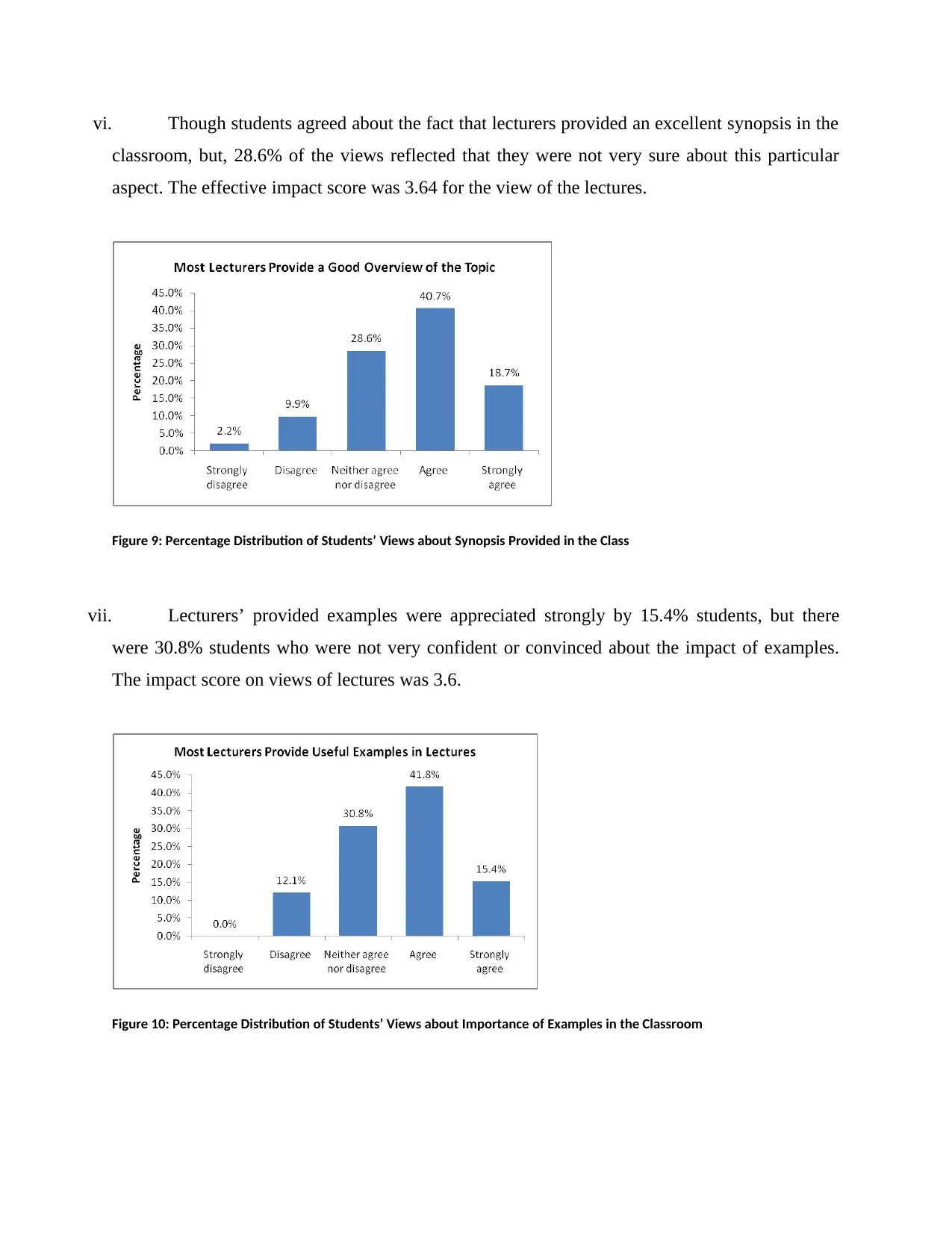
vi. Though students agreed about the fact that lecturers provided an excellent synopsis in the
classroom, but, 28.6% of the views reflected that they were not very sure about this particular
aspect. The effective impact score was 3.64 for the view of the lectures.
Figure 9: Percentage Distribution of Students’ Views about Synopsis Provided in the Class
vii. Lecturers’ provided examples were appreciated strongly by 15.4% students, but there
were 30.8% students who were not very confident or convinced about the impact of examples.
The impact score on views of lectures was 3.6.
Figure 10: Percentage Distribution of Students’ Views about Importance of Examples in the Classroom
classroom, but, 28.6% of the views reflected that they were not very sure about this particular
aspect. The effective impact score was 3.64 for the view of the lectures.
Figure 9: Percentage Distribution of Students’ Views about Synopsis Provided in the Class
vii. Lecturers’ provided examples were appreciated strongly by 15.4% students, but there
were 30.8% students who were not very confident or convinced about the impact of examples.
The impact score on views of lectures was 3.6.
Figure 10: Percentage Distribution of Students’ Views about Importance of Examples in the Classroom
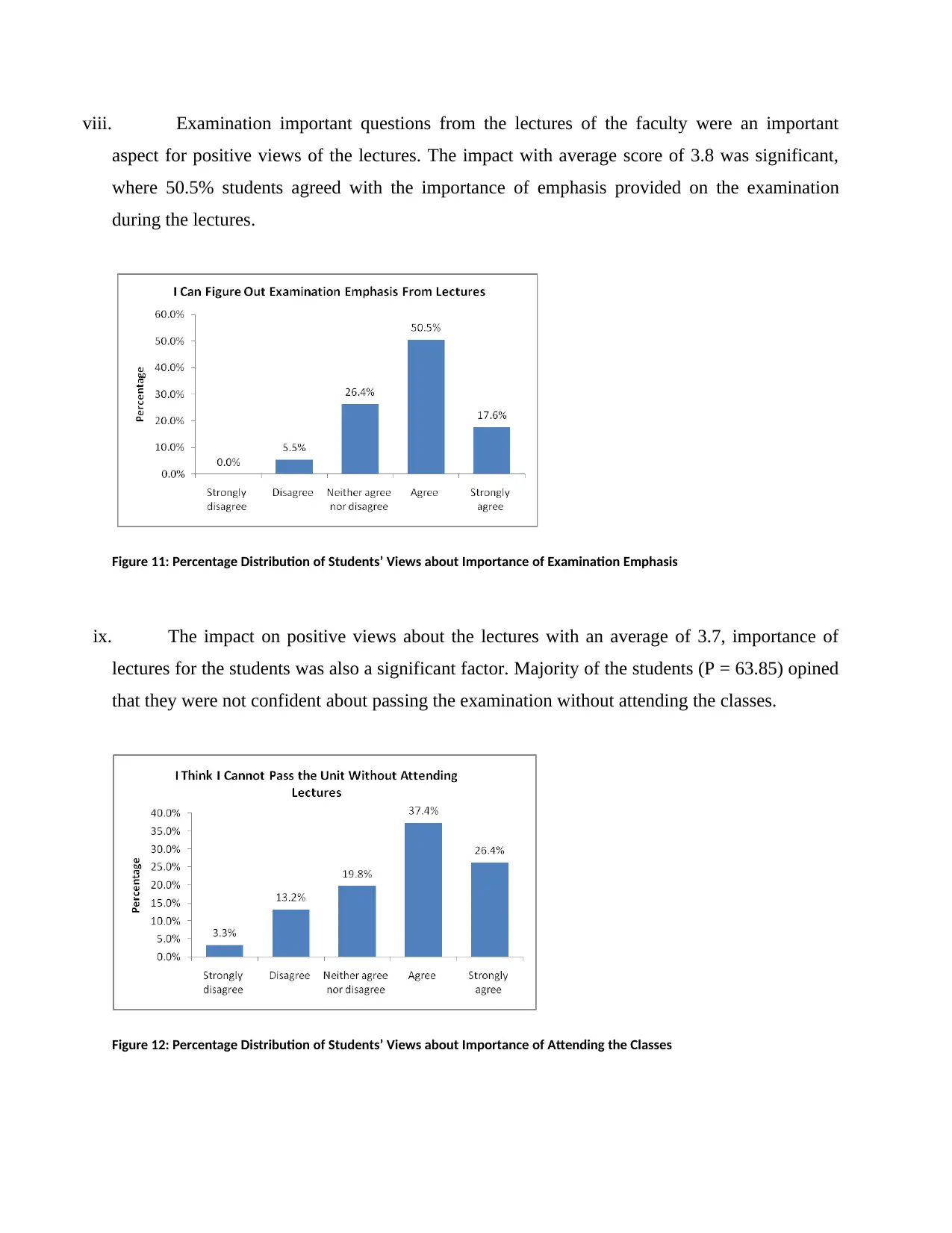
viii. Examination important questions from the lectures of the faculty were an important
aspect for positive views of the lectures. The impact with average score of 3.8 was significant,
where 50.5% students agreed with the importance of emphasis provided on the examination
during the lectures.
Figure 11: Percentage Distribution of Students’ Views about Importance of Examination Emphasis
ix. The impact on positive views about the lectures with an average of 3.7, importance of
lectures for the students was also a significant factor. Majority of the students (P = 63.85) opined
that they were not confident about passing the examination without attending the classes.
Figure 12: Percentage Distribution of Students’ Views about Importance of Attending the Classes
aspect for positive views of the lectures. The impact with average score of 3.8 was significant,
where 50.5% students agreed with the importance of emphasis provided on the examination
during the lectures.
Figure 11: Percentage Distribution of Students’ Views about Importance of Examination Emphasis
ix. The impact on positive views about the lectures with an average of 3.7, importance of
lectures for the students was also a significant factor. Majority of the students (P = 63.85) opined
that they were not confident about passing the examination without attending the classes.
Figure 12: Percentage Distribution of Students’ Views about Importance of Attending the Classes
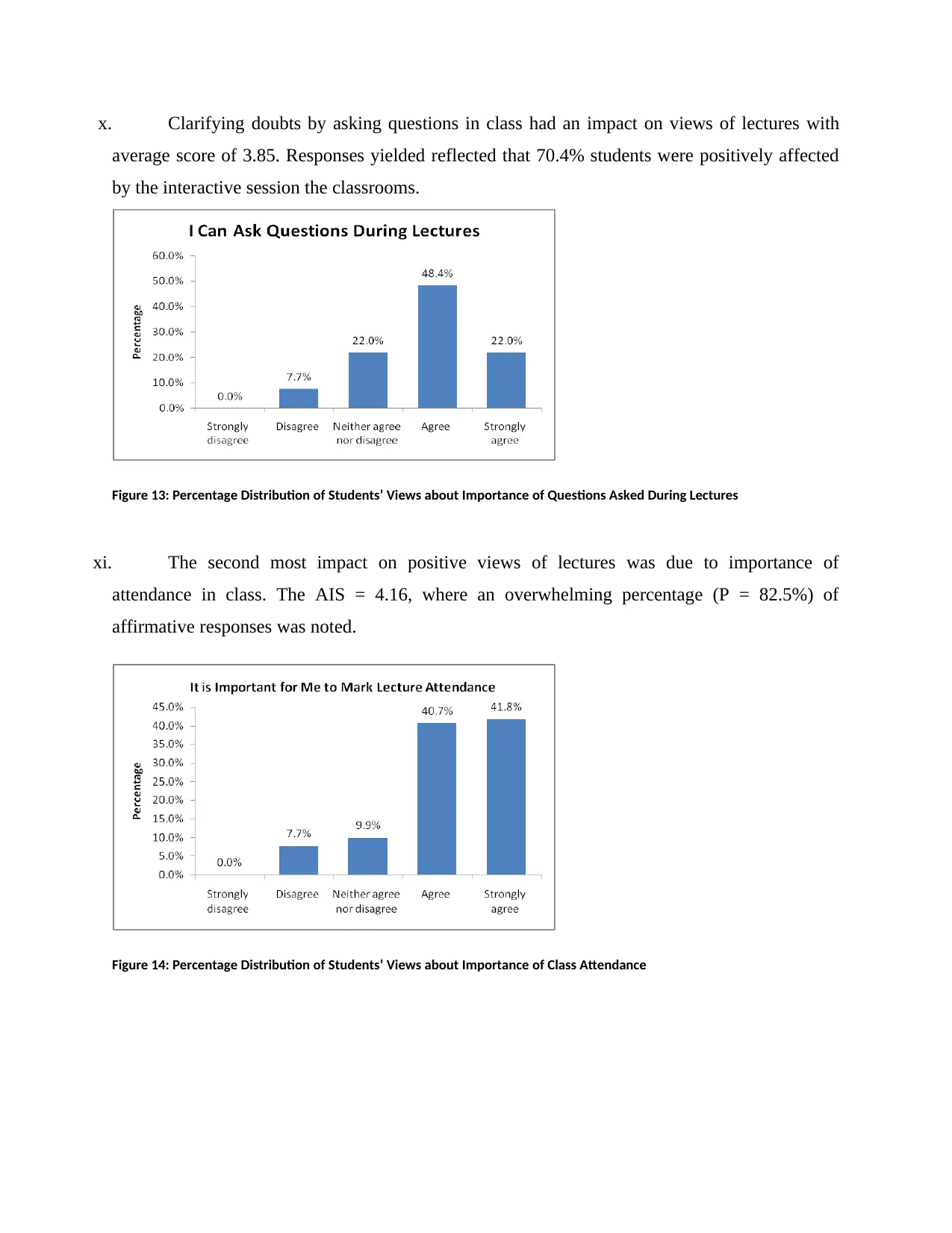
x. Clarifying doubts by asking questions in class had an impact on views of lectures with
average score of 3.85. Responses yielded reflected that 70.4% students were positively affected
by the interactive session the classrooms.
Figure 13: Percentage Distribution of Students’ Views about Importance of Questions Asked During Lectures
xi. The second most impact on positive views of lectures was due to importance of
attendance in class. The AIS = 4.16, where an overwhelming percentage (P = 82.5%) of
affirmative responses was noted.
Figure 14: Percentage Distribution of Students’ Views about Importance of Class Attendance
average score of 3.85. Responses yielded reflected that 70.4% students were positively affected
by the interactive session the classrooms.
Figure 13: Percentage Distribution of Students’ Views about Importance of Questions Asked During Lectures
xi. The second most impact on positive views of lectures was due to importance of
attendance in class. The AIS = 4.16, where an overwhelming percentage (P = 82.5%) of
affirmative responses was noted.
Figure 14: Percentage Distribution of Students’ Views about Importance of Class Attendance
Paraphrase This Document
Need a fresh take? Get an instant paraphrase of this document with our AI Paraphraser
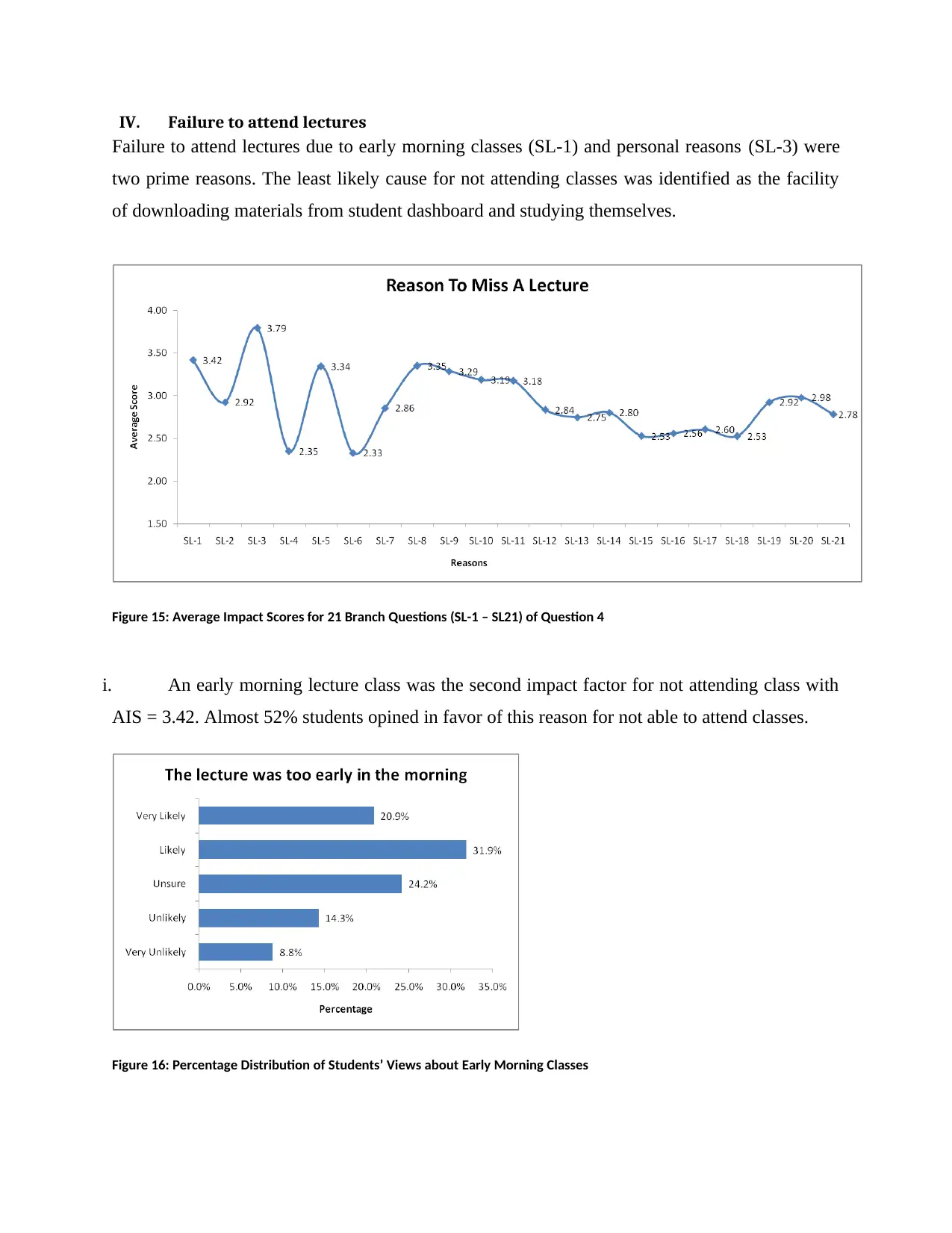
IV. Failure to attend lectures
Failure to attend lectures due to early morning classes (SL-1) and personal reasons (SL-3) were
two prime reasons. The least likely cause for not attending classes was identified as the facility
of downloading materials from student dashboard and studying themselves.
Figure 15: Average Impact Scores for 21 Branch Questions (SL-1 – SL21) of Question 4
i. An early morning lecture class was the second impact factor for not attending class with
AIS = 3.42. Almost 52% students opined in favor of this reason for not able to attend classes.
Figure 16: Percentage Distribution of Students’ Views about Early Morning Classes
Failure to attend lectures due to early morning classes (SL-1) and personal reasons (SL-3) were
two prime reasons. The least likely cause for not attending classes was identified as the facility
of downloading materials from student dashboard and studying themselves.
Figure 15: Average Impact Scores for 21 Branch Questions (SL-1 – SL21) of Question 4
i. An early morning lecture class was the second impact factor for not attending class with
AIS = 3.42. Almost 52% students opined in favor of this reason for not able to attend classes.
Figure 16: Percentage Distribution of Students’ Views about Early Morning Classes
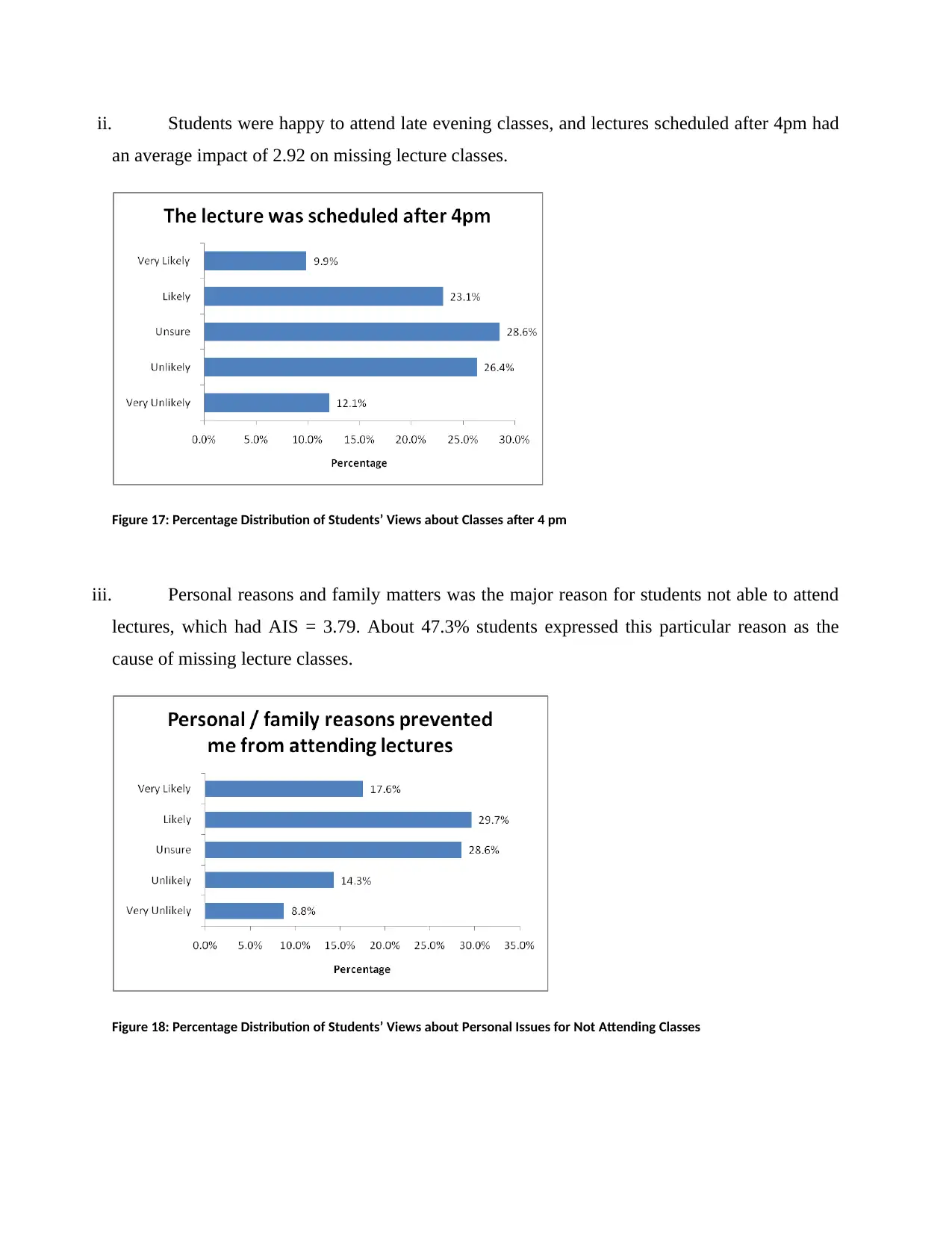
ii. Students were happy to attend late evening classes, and lectures scheduled after 4pm had
an average impact of 2.92 on missing lecture classes.
Figure 17: Percentage Distribution of Students’ Views about Classes after 4 pm
iii. Personal reasons and family matters was the major reason for students not able to attend
lectures, which had AIS = 3.79. About 47.3% students expressed this particular reason as the
cause of missing lecture classes.
Figure 18: Percentage Distribution of Students’ Views about Personal Issues for Not Attending Classes
an average impact of 2.92 on missing lecture classes.
Figure 17: Percentage Distribution of Students’ Views about Classes after 4 pm
iii. Personal reasons and family matters was the major reason for students not able to attend
lectures, which had AIS = 3.79. About 47.3% students expressed this particular reason as the
cause of missing lecture classes.
Figure 18: Percentage Distribution of Students’ Views about Personal Issues for Not Attending Classes
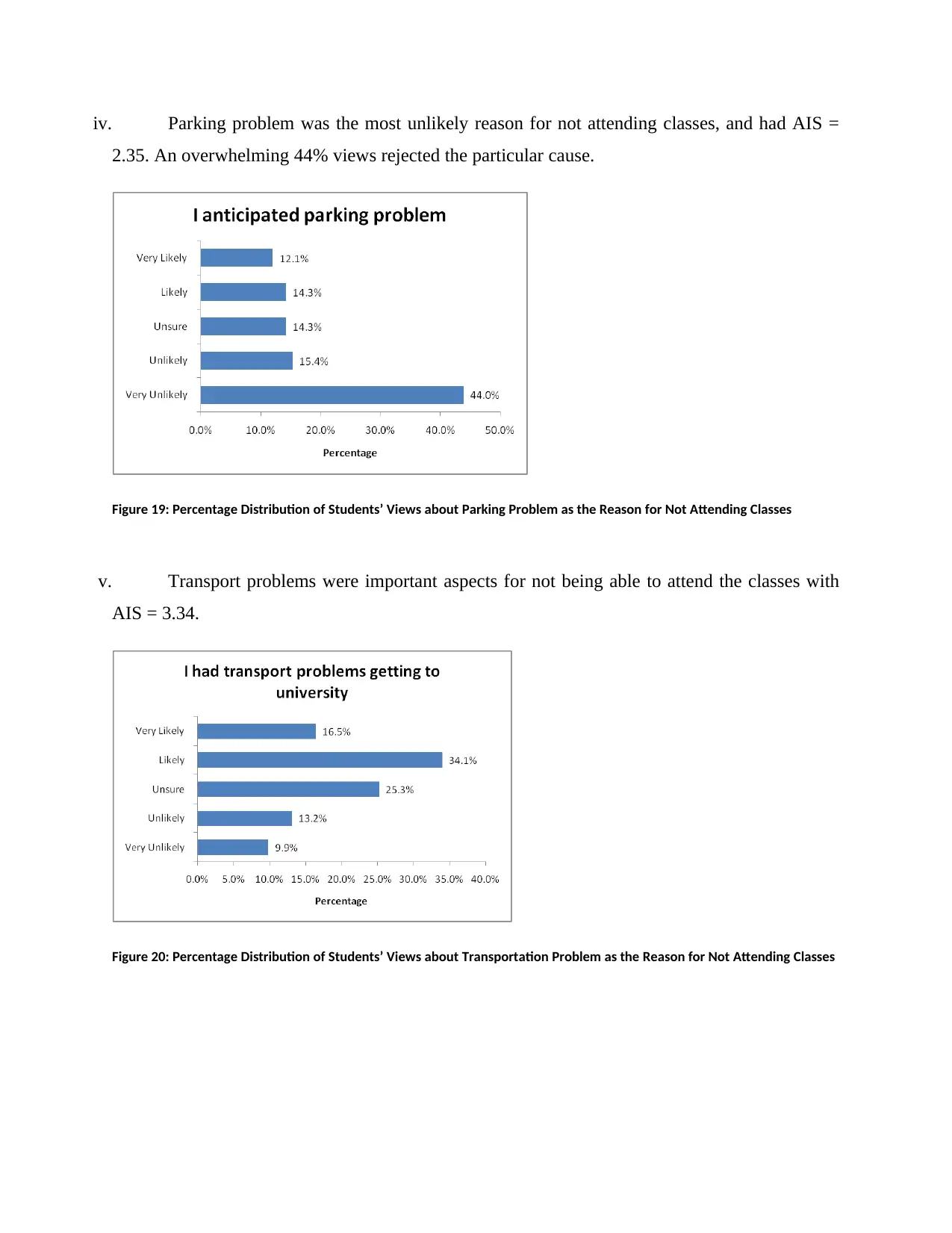
iv. Parking problem was the most unlikely reason for not attending classes, and had AIS =
2.35. An overwhelming 44% views rejected the particular cause.
Figure 19: Percentage Distribution of Students’ Views about Parking Problem as the Reason for Not Attending Classes
v. Transport problems were important aspects for not being able to attend the classes with
AIS = 3.34.
Figure 20: Percentage Distribution of Students’ Views about Transportation Problem as the Reason for Not Attending Classes
2.35. An overwhelming 44% views rejected the particular cause.
Figure 19: Percentage Distribution of Students’ Views about Parking Problem as the Reason for Not Attending Classes
v. Transport problems were important aspects for not being able to attend the classes with
AIS = 3.34.
Figure 20: Percentage Distribution of Students’ Views about Transportation Problem as the Reason for Not Attending Classes
Secure Best Marks with AI Grader
Need help grading? Try our AI Grader for instant feedback on your assignments.
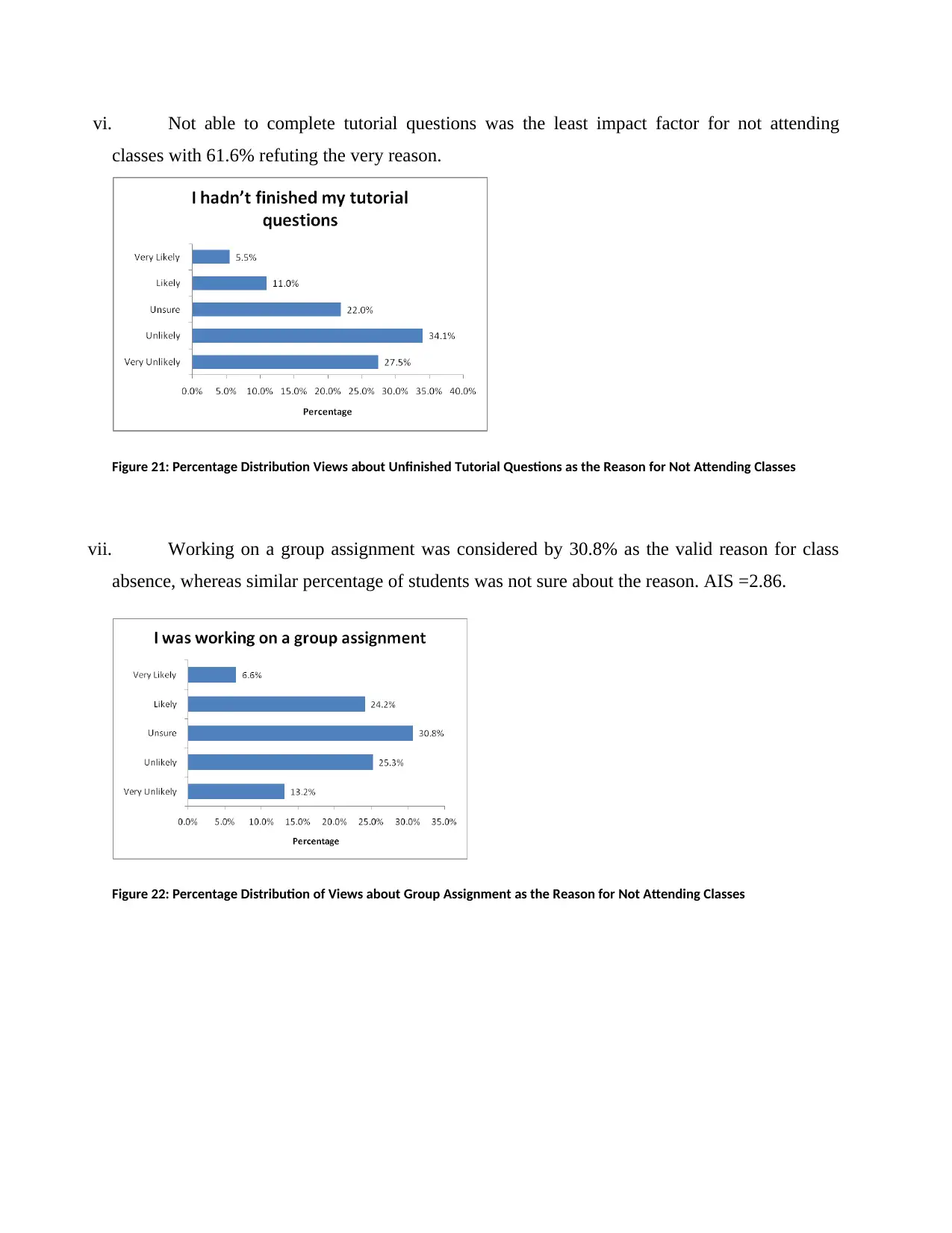
vi. Not able to complete tutorial questions was the least impact factor for not attending
classes with 61.6% refuting the very reason.
Figure 21: Percentage Distribution Views about Unfinished Tutorial Questions as the Reason for Not Attending Classes
vii. Working on a group assignment was considered by 30.8% as the valid reason for class
absence, whereas similar percentage of students was not sure about the reason. AIS =2.86.
Figure 22: Percentage Distribution of Views about Group Assignment as the Reason for Not Attending Classes
classes with 61.6% refuting the very reason.
Figure 21: Percentage Distribution Views about Unfinished Tutorial Questions as the Reason for Not Attending Classes
vii. Working on a group assignment was considered by 30.8% as the valid reason for class
absence, whereas similar percentage of students was not sure about the reason. AIS =2.86.
Figure 22: Percentage Distribution of Views about Group Assignment as the Reason for Not Attending Classes
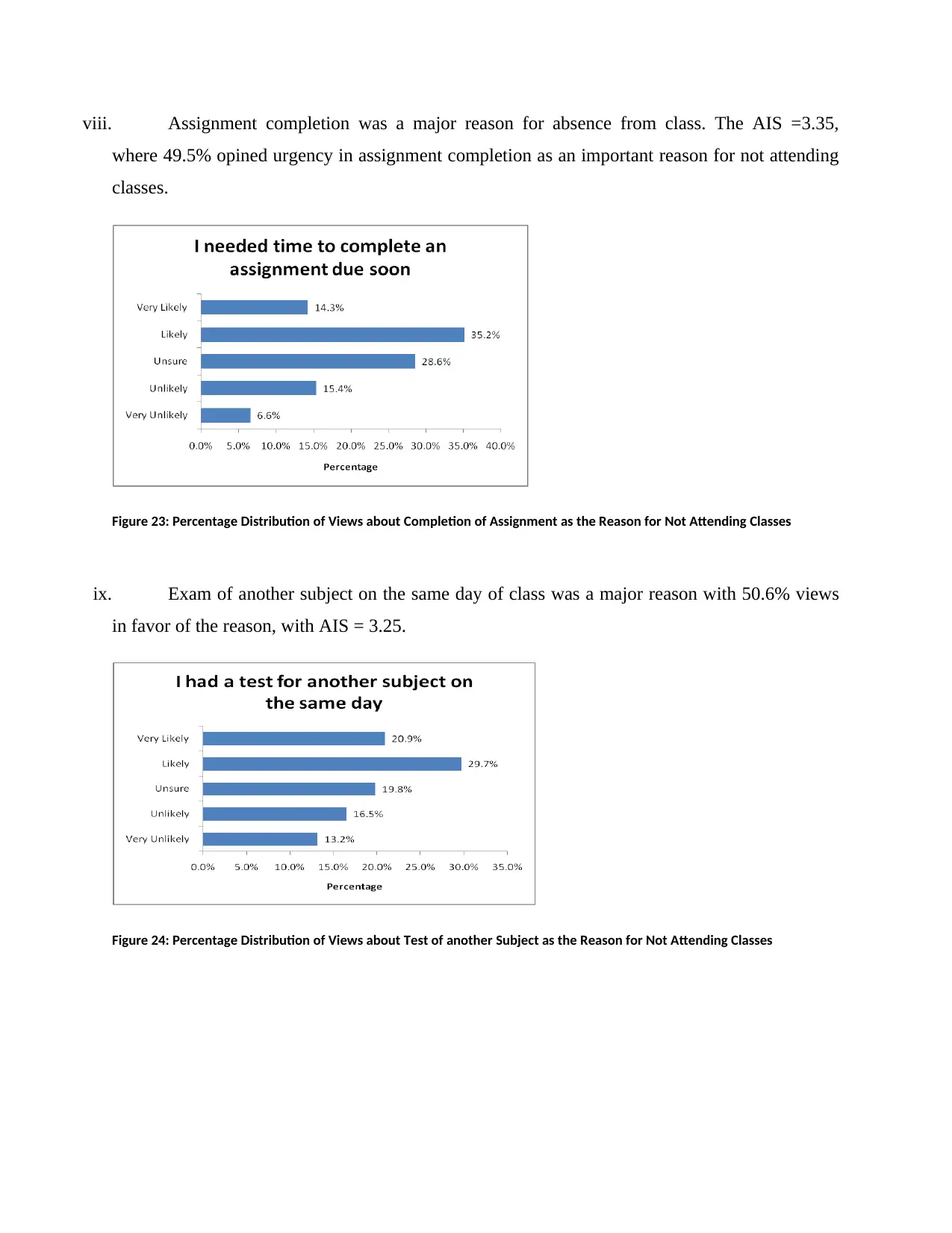
viii. Assignment completion was a major reason for absence from class. The AIS =3.35,
where 49.5% opined urgency in assignment completion as an important reason for not attending
classes.
Figure 23: Percentage Distribution of Views about Completion of Assignment as the Reason for Not Attending Classes
ix. Exam of another subject on the same day of class was a major reason with 50.6% views
in favor of the reason, with AIS = 3.25.
Figure 24: Percentage Distribution of Views about Test of another Subject as the Reason for Not Attending Classes
where 49.5% opined urgency in assignment completion as an important reason for not attending
classes.
Figure 23: Percentage Distribution of Views about Completion of Assignment as the Reason for Not Attending Classes
ix. Exam of another subject on the same day of class was a major reason with 50.6% views
in favor of the reason, with AIS = 3.25.
Figure 24: Percentage Distribution of Views about Test of another Subject as the Reason for Not Attending Classes
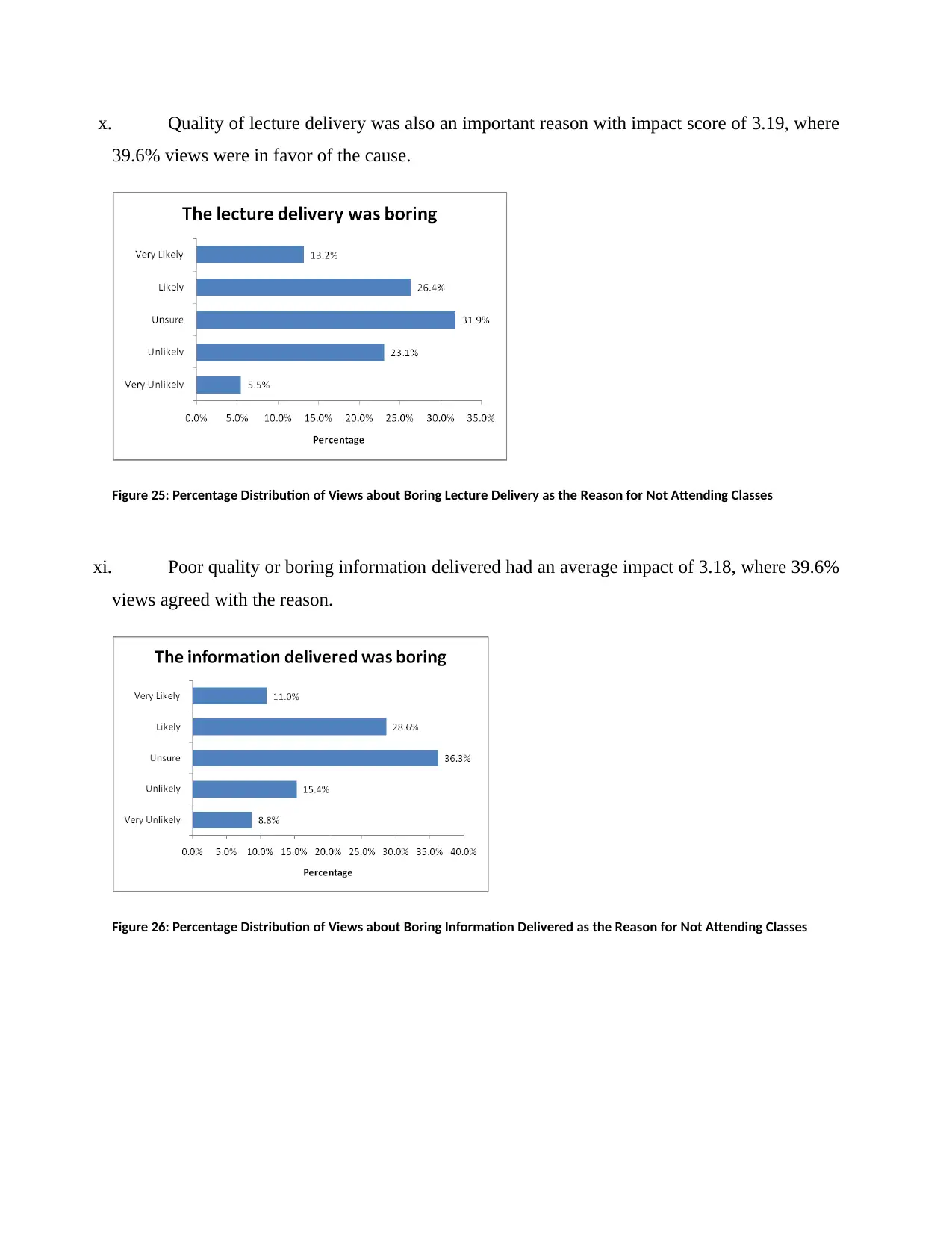
x. Quality of lecture delivery was also an important reason with impact score of 3.19, where
39.6% views were in favor of the cause.
Figure 25: Percentage Distribution of Views about Boring Lecture Delivery as the Reason for Not Attending Classes
xi. Poor quality or boring information delivered had an average impact of 3.18, where 39.6%
views agreed with the reason.
Figure 26: Percentage Distribution of Views about Boring Information Delivered as the Reason for Not Attending Classes
39.6% views were in favor of the cause.
Figure 25: Percentage Distribution of Views about Boring Lecture Delivery as the Reason for Not Attending Classes
xi. Poor quality or boring information delivered had an average impact of 3.18, where 39.6%
views agreed with the reason.
Figure 26: Percentage Distribution of Views about Boring Information Delivered as the Reason for Not Attending Classes
Paraphrase This Document
Need a fresh take? Get an instant paraphrase of this document with our AI Paraphraser
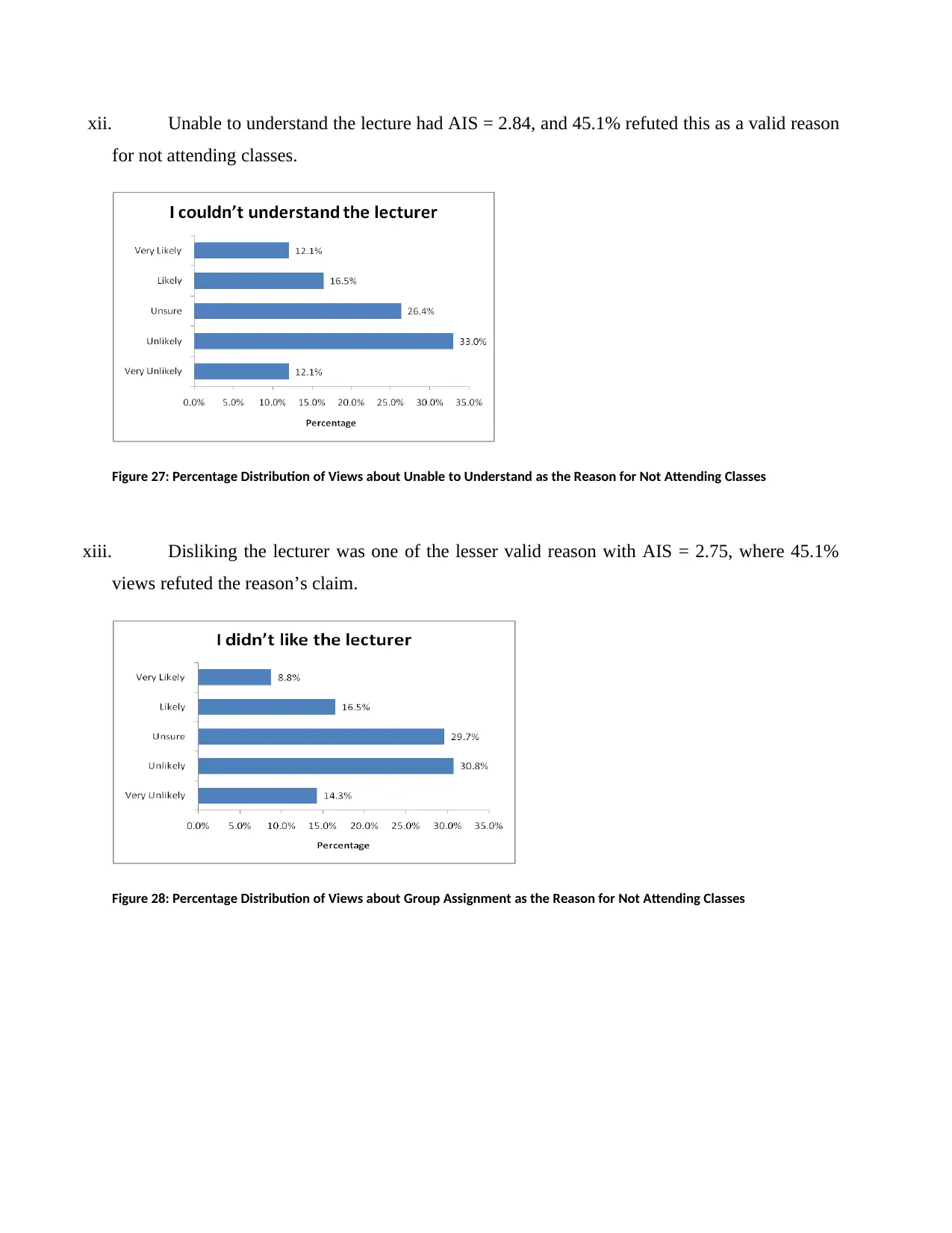
xii. Unable to understand the lecture had AIS = 2.84, and 45.1% refuted this as a valid reason
for not attending classes.
Figure 27: Percentage Distribution of Views about Unable to Understand as the Reason for Not Attending Classes
xiii. Disliking the lecturer was one of the lesser valid reason with AIS = 2.75, where 45.1%
views refuted the reason’s claim.
Figure 28: Percentage Distribution of Views about Group Assignment as the Reason for Not Attending Classes
for not attending classes.
Figure 27: Percentage Distribution of Views about Unable to Understand as the Reason for Not Attending Classes
xiii. Disliking the lecturer was one of the lesser valid reason with AIS = 2.75, where 45.1%
views refuted the reason’s claim.
Figure 28: Percentage Distribution of Views about Group Assignment as the Reason for Not Attending Classes
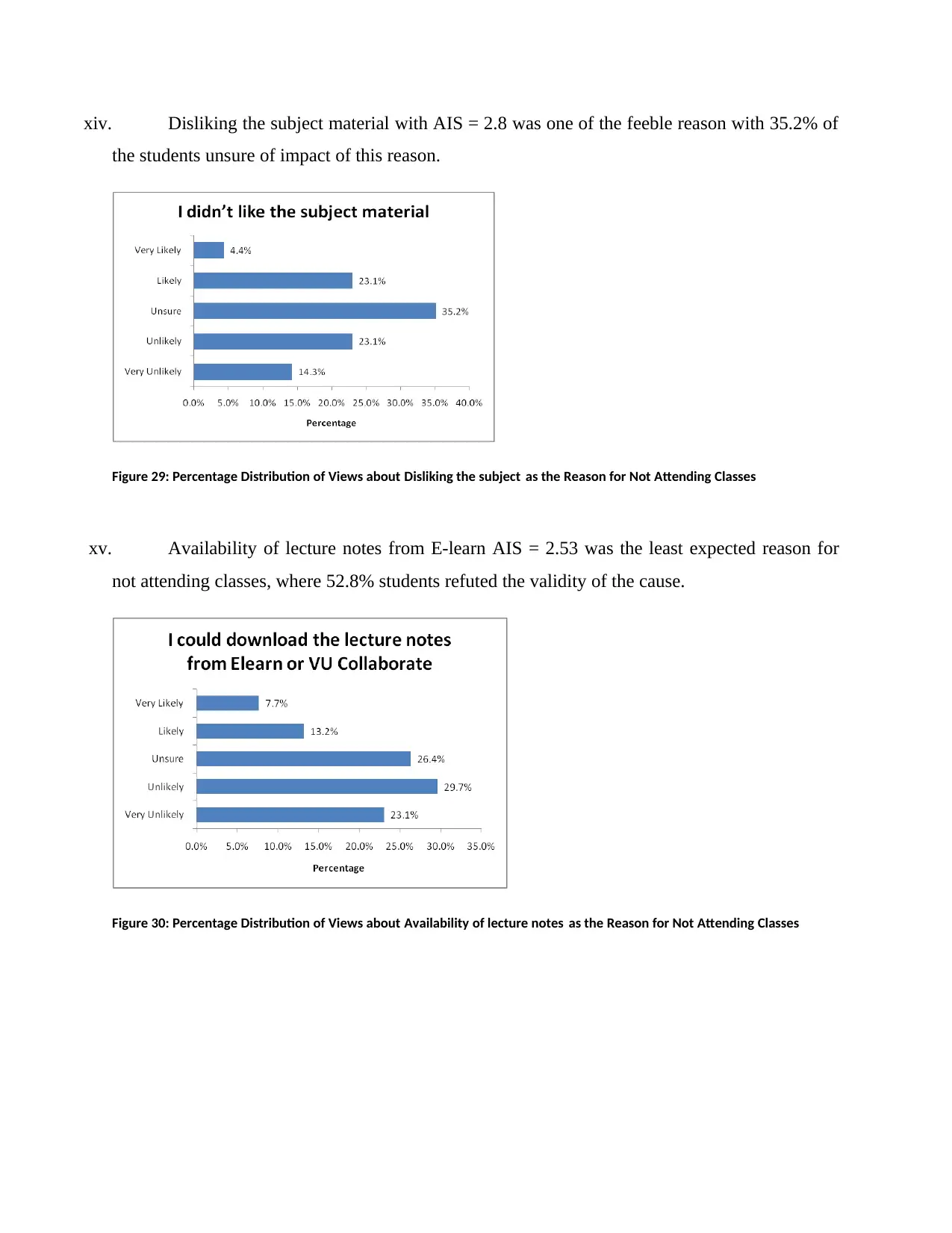
xiv. Disliking the subject material with AIS = 2.8 was one of the feeble reason with 35.2% of
the students unsure of impact of this reason.
Figure 29: Percentage Distribution of Views about Disliking the subject as the Reason for Not Attending Classes
xv. Availability of lecture notes from E-learn AIS = 2.53 was the least expected reason for
not attending classes, where 52.8% students refuted the validity of the cause.
Figure 30: Percentage Distribution of Views about Availability of lecture notes as the Reason for Not Attending Classes
the students unsure of impact of this reason.
Figure 29: Percentage Distribution of Views about Disliking the subject as the Reason for Not Attending Classes
xv. Availability of lecture notes from E-learn AIS = 2.53 was the least expected reason for
not attending classes, where 52.8% students refuted the validity of the cause.
Figure 30: Percentage Distribution of Views about Availability of lecture notes as the Reason for Not Attending Classes
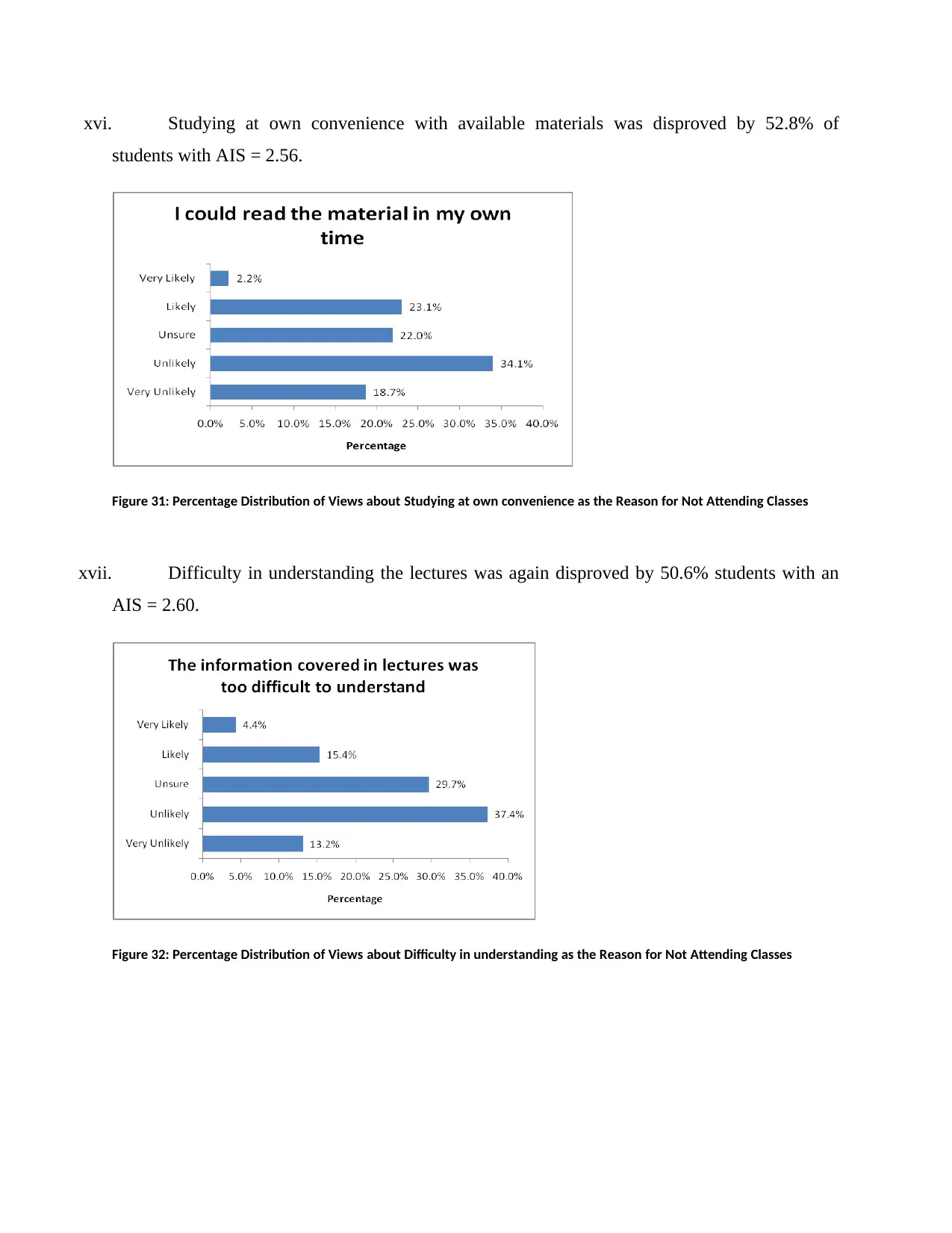
xvi. Studying at own convenience with available materials was disproved by 52.8% of
students with AIS = 2.56.
Figure 31: Percentage Distribution of Views about Studying at own convenience as the Reason for Not Attending Classes
xvii. Difficulty in understanding the lectures was again disproved by 50.6% students with an
AIS = 2.60.
Figure 32: Percentage Distribution of Views about Difficulty in understanding as the Reason for Not Attending Classes
students with AIS = 2.56.
Figure 31: Percentage Distribution of Views about Studying at own convenience as the Reason for Not Attending Classes
xvii. Difficulty in understanding the lectures was again disproved by 50.6% students with an
AIS = 2.60.
Figure 32: Percentage Distribution of Views about Difficulty in understanding as the Reason for Not Attending Classes
Secure Best Marks with AI Grader
Need help grading? Try our AI Grader for instant feedback on your assignments.
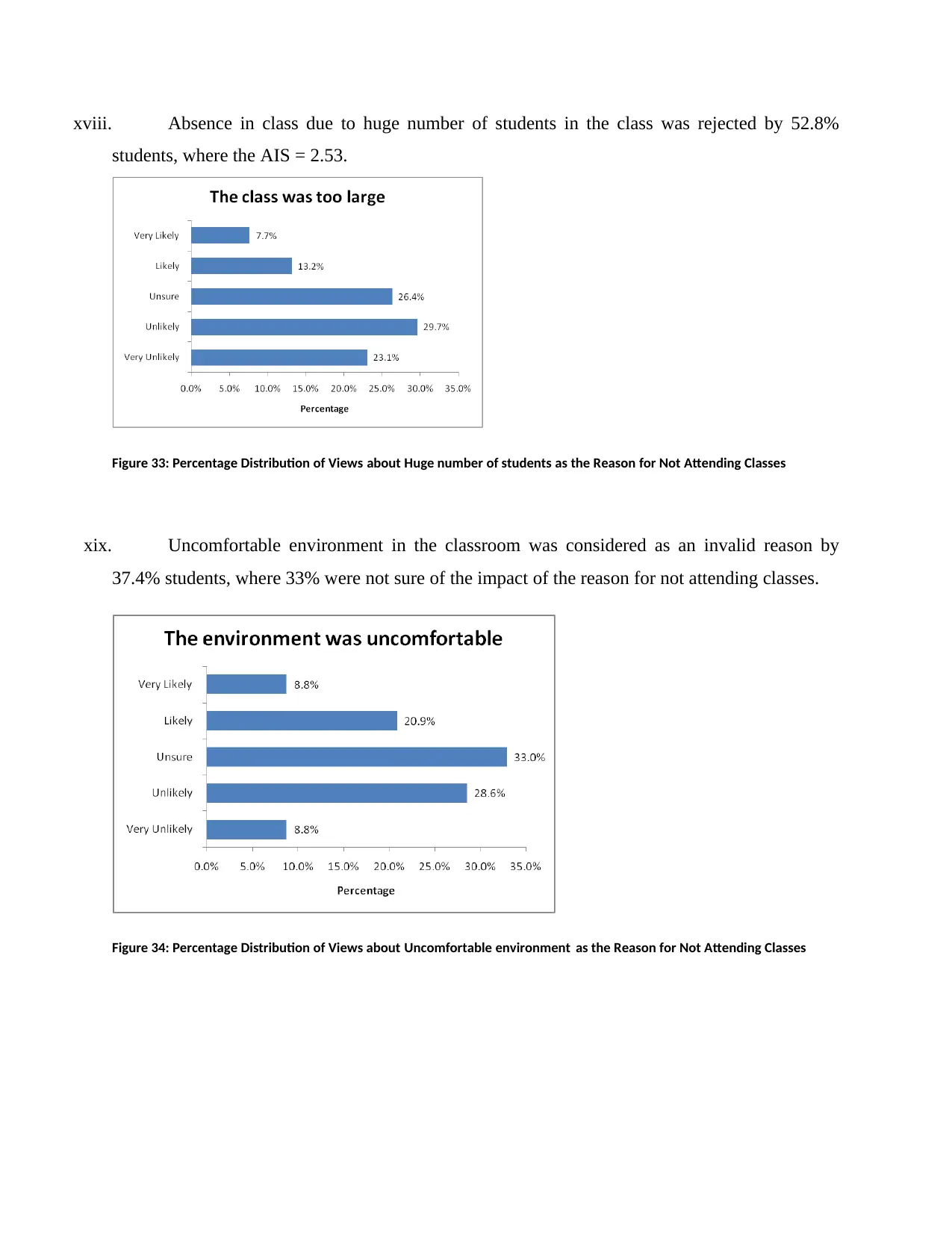
xviii. Absence in class due to huge number of students in the class was rejected by 52.8%
students, where the AIS = 2.53.
Figure 33: Percentage Distribution of Views about Huge number of students as the Reason for Not Attending Classes
xix. Uncomfortable environment in the classroom was considered as an invalid reason by
37.4% students, where 33% were not sure of the impact of the reason for not attending classes.
Figure 34: Percentage Distribution of Views about Uncomfortable environment as the Reason for Not Attending Classes
students, where the AIS = 2.53.
Figure 33: Percentage Distribution of Views about Huge number of students as the Reason for Not Attending Classes
xix. Uncomfortable environment in the classroom was considered as an invalid reason by
37.4% students, where 33% were not sure of the impact of the reason for not attending classes.
Figure 34: Percentage Distribution of Views about Uncomfortable environment as the Reason for Not Attending Classes
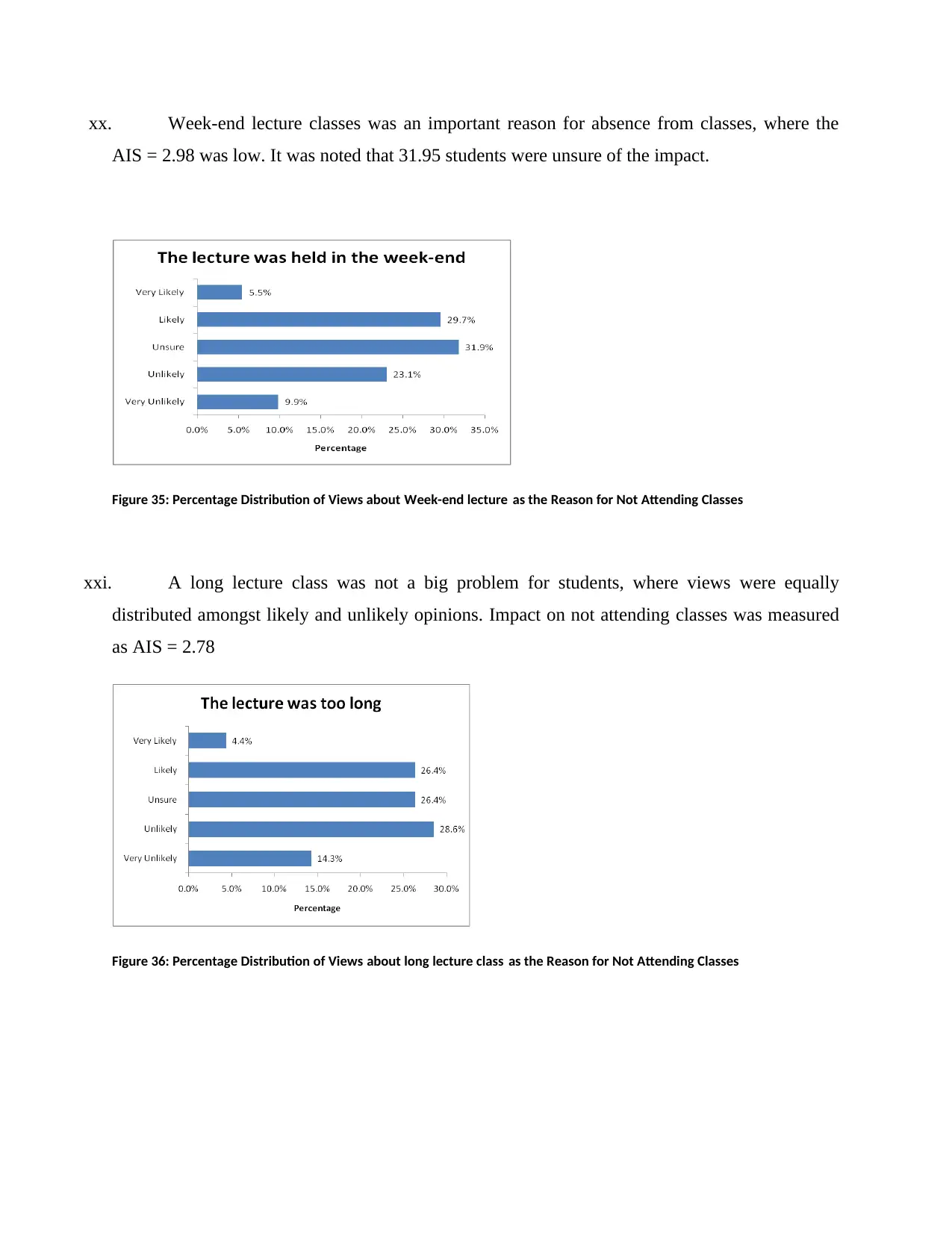
xx. Week-end lecture classes was an important reason for absence from classes, where the
AIS = 2.98 was low. It was noted that 31.95 students were unsure of the impact.
Figure 35: Percentage Distribution of Views about Week-end lecture as the Reason for Not Attending Classes
xxi. A long lecture class was not a big problem for students, where views were equally
distributed amongst likely and unlikely opinions. Impact on not attending classes was measured
as AIS = 2.78
Figure 36: Percentage Distribution of Views about long lecture class as the Reason for Not Attending Classes
AIS = 2.98 was low. It was noted that 31.95 students were unsure of the impact.
Figure 35: Percentage Distribution of Views about Week-end lecture as the Reason for Not Attending Classes
xxi. A long lecture class was not a big problem for students, where views were equally
distributed amongst likely and unlikely opinions. Impact on not attending classes was measured
as AIS = 2.78
Figure 36: Percentage Distribution of Views about long lecture class as the Reason for Not Attending Classes
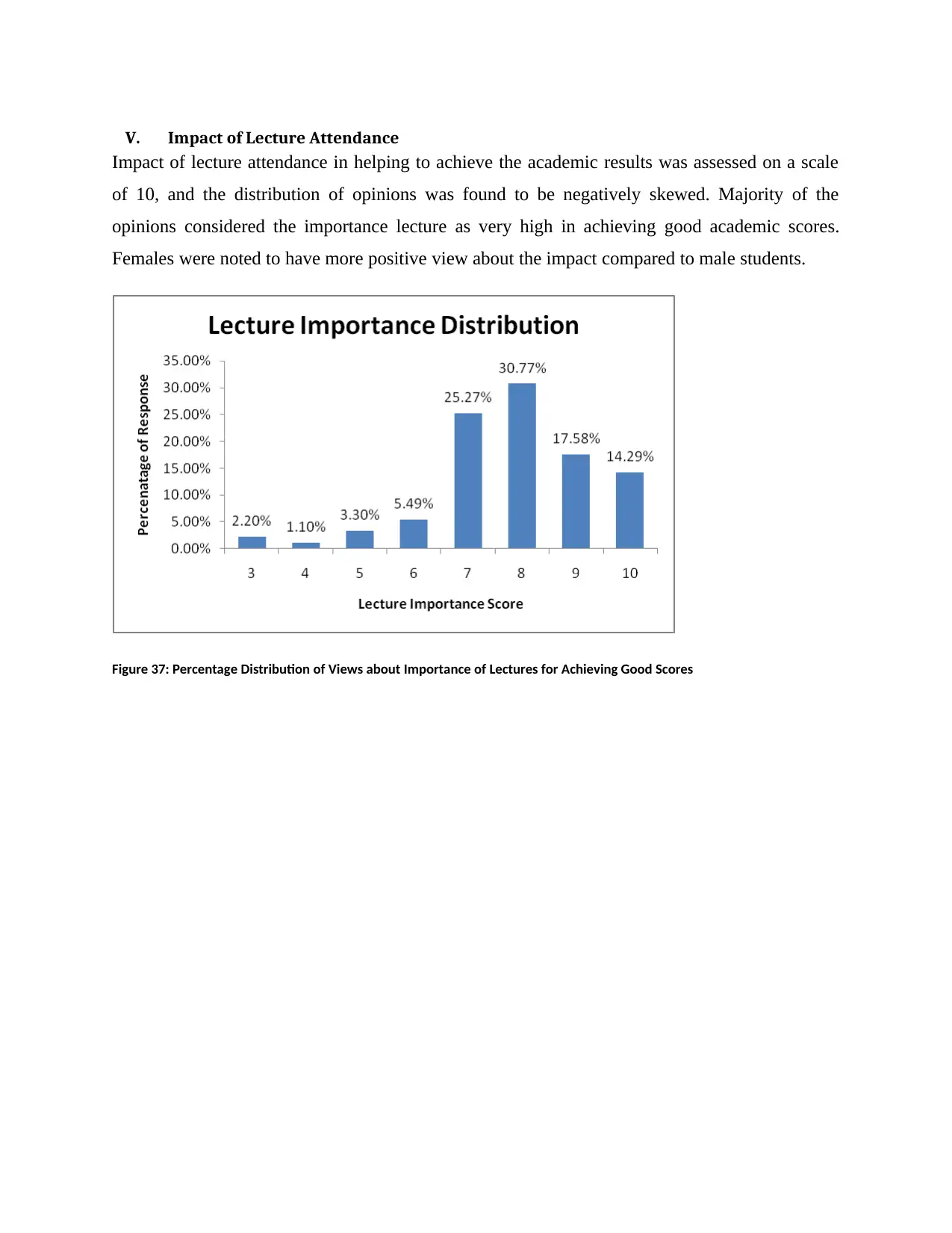
V. Impact of Lecture Attendance
Impact of lecture attendance in helping to achieve the academic results was assessed on a scale
of 10, and the distribution of opinions was found to be negatively skewed. Majority of the
opinions considered the importance lecture as very high in achieving good academic scores.
Females were noted to have more positive view about the impact compared to male students.
Figure 37: Percentage Distribution of Views about Importance of Lectures for Achieving Good Scores
Impact of lecture attendance in helping to achieve the academic results was assessed on a scale
of 10, and the distribution of opinions was found to be negatively skewed. Majority of the
opinions considered the importance lecture as very high in achieving good academic scores.
Females were noted to have more positive view about the impact compared to male students.
Figure 37: Percentage Distribution of Views about Importance of Lectures for Achieving Good Scores
Paraphrase This Document
Need a fresh take? Get an instant paraphrase of this document with our AI Paraphraser
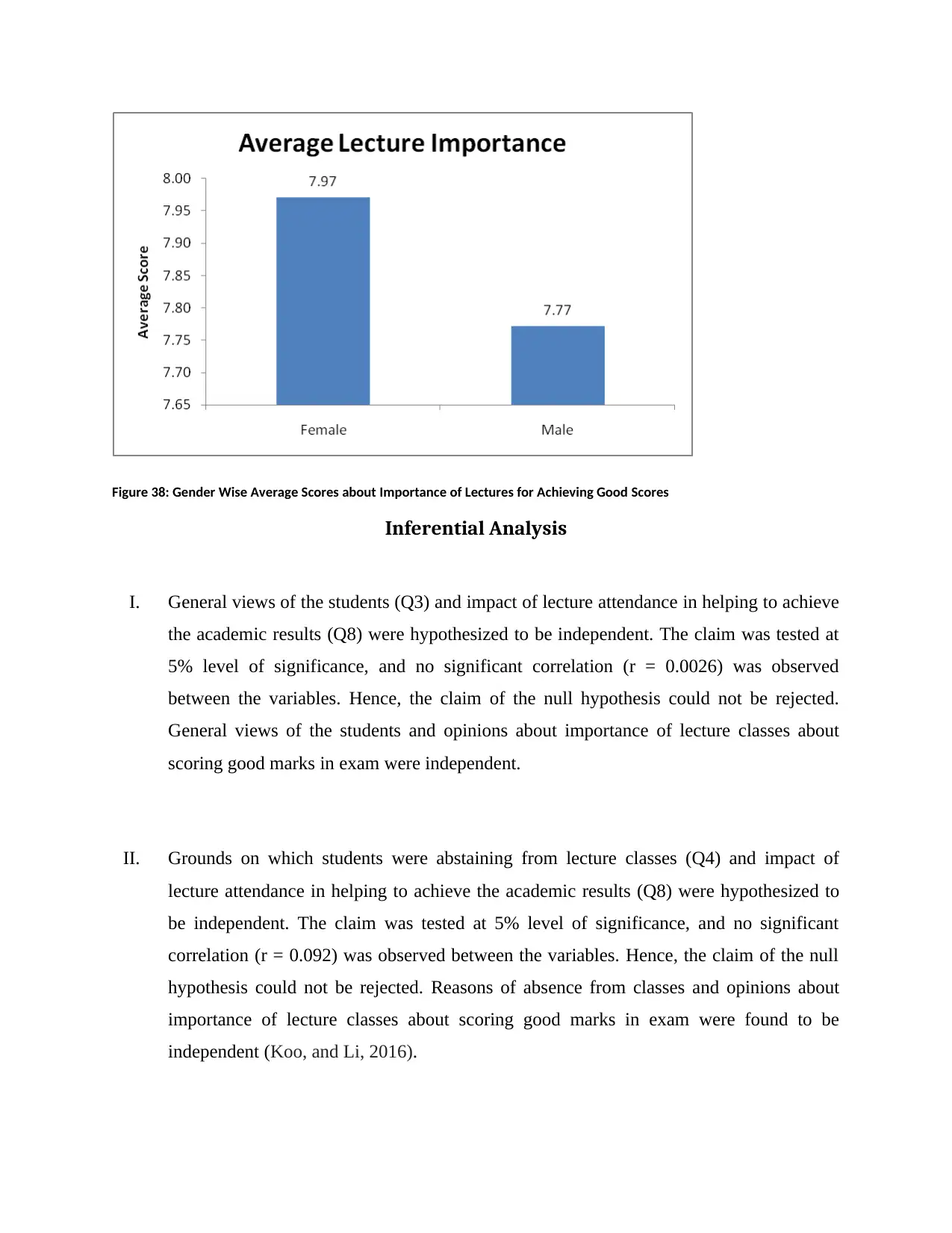
Figure 38: Gender Wise Average Scores about Importance of Lectures for Achieving Good Scores
Inferential Analysis
I. General views of the students (Q3) and impact of lecture attendance in helping to achieve
the academic results (Q8) were hypothesized to be independent. The claim was tested at
5% level of significance, and no significant correlation (r = 0.0026) was observed
between the variables. Hence, the claim of the null hypothesis could not be rejected.
General views of the students and opinions about importance of lecture classes about
scoring good marks in exam were independent.
II. Grounds on which students were abstaining from lecture classes (Q4) and impact of
lecture attendance in helping to achieve the academic results (Q8) were hypothesized to
be independent. The claim was tested at 5% level of significance, and no significant
correlation (r = 0.092) was observed between the variables. Hence, the claim of the null
hypothesis could not be rejected. Reasons of absence from classes and opinions about
importance of lecture classes about scoring good marks in exam were found to be
independent (Koo, and Li, 2016).
Inferential Analysis
I. General views of the students (Q3) and impact of lecture attendance in helping to achieve
the academic results (Q8) were hypothesized to be independent. The claim was tested at
5% level of significance, and no significant correlation (r = 0.0026) was observed
between the variables. Hence, the claim of the null hypothesis could not be rejected.
General views of the students and opinions about importance of lecture classes about
scoring good marks in exam were independent.
II. Grounds on which students were abstaining from lecture classes (Q4) and impact of
lecture attendance in helping to achieve the academic results (Q8) were hypothesized to
be independent. The claim was tested at 5% level of significance, and no significant
correlation (r = 0.092) was observed between the variables. Hence, the claim of the null
hypothesis could not be rejected. Reasons of absence from classes and opinions about
importance of lecture classes about scoring good marks in exam were found to be
independent (Koo, and Li, 2016).
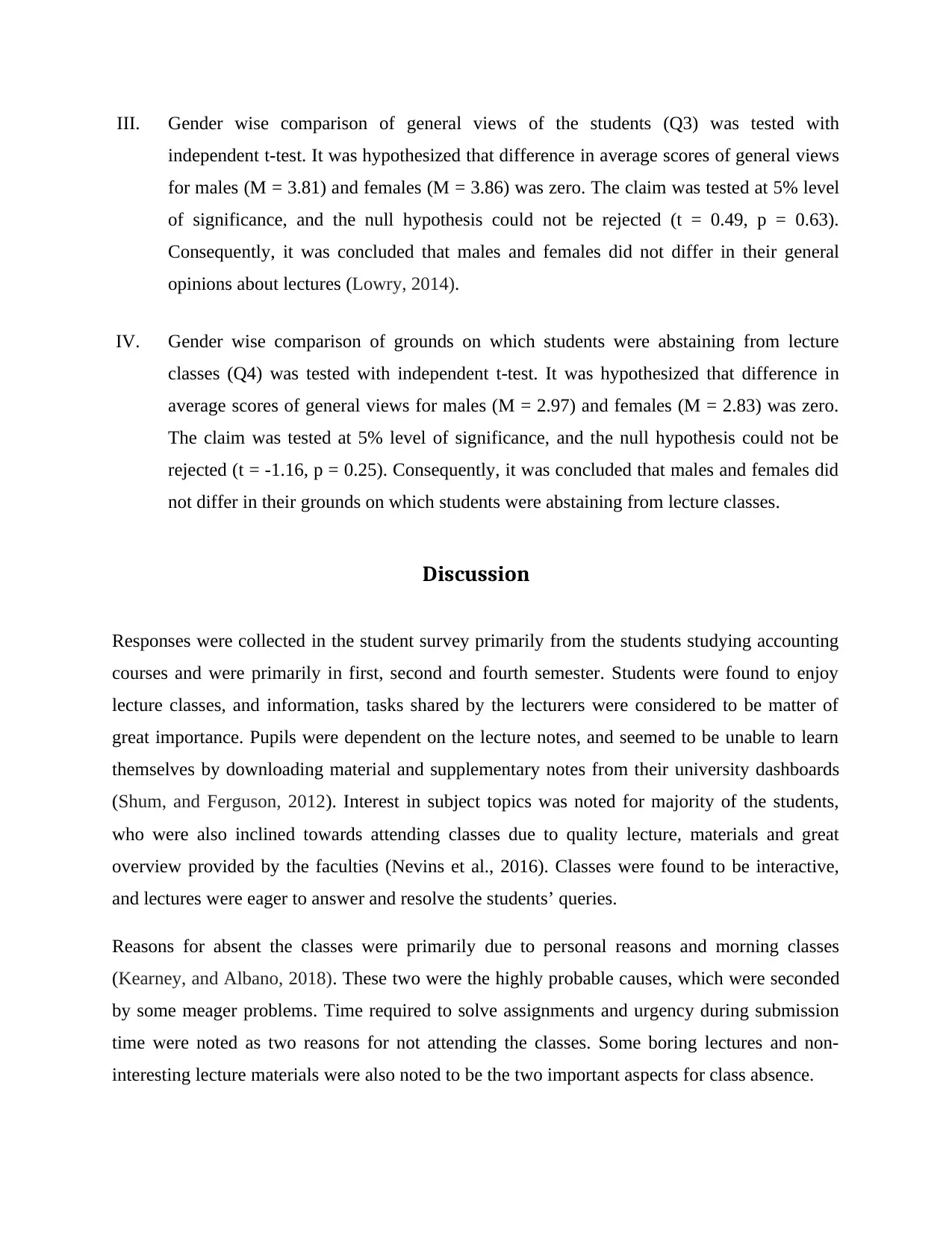
III. Gender wise comparison of general views of the students (Q3) was tested with
independent t-test. It was hypothesized that difference in average scores of general views
for males (M = 3.81) and females (M = 3.86) was zero. The claim was tested at 5% level
of significance, and the null hypothesis could not be rejected (t = 0.49, p = 0.63).
Consequently, it was concluded that males and females did not differ in their general
opinions about lectures (Lowry, 2014).
IV. Gender wise comparison of grounds on which students were abstaining from lecture
classes (Q4) was tested with independent t-test. It was hypothesized that difference in
average scores of general views for males (M = 2.97) and females (M = 2.83) was zero.
The claim was tested at 5% level of significance, and the null hypothesis could not be
rejected (t = -1.16, p = 0.25). Consequently, it was concluded that males and females did
not differ in their grounds on which students were abstaining from lecture classes.
Discussion
Responses were collected in the student survey primarily from the students studying accounting
courses and were primarily in first, second and fourth semester. Students were found to enjoy
lecture classes, and information, tasks shared by the lecturers were considered to be matter of
great importance. Pupils were dependent on the lecture notes, and seemed to be unable to learn
themselves by downloading material and supplementary notes from their university dashboards
(Shum, and Ferguson, 2012). Interest in subject topics was noted for majority of the students,
who were also inclined towards attending classes due to quality lecture, materials and great
overview provided by the faculties (Nevins et al., 2016). Classes were found to be interactive,
and lectures were eager to answer and resolve the students’ queries.
Reasons for absent the classes were primarily due to personal reasons and morning classes
(Kearney, and Albano, 2018). These two were the highly probable causes, which were seconded
by some meager problems. Time required to solve assignments and urgency during submission
time were noted as two reasons for not attending the classes. Some boring lectures and non-
interesting lecture materials were also noted to be the two important aspects for class absence.
independent t-test. It was hypothesized that difference in average scores of general views
for males (M = 3.81) and females (M = 3.86) was zero. The claim was tested at 5% level
of significance, and the null hypothesis could not be rejected (t = 0.49, p = 0.63).
Consequently, it was concluded that males and females did not differ in their general
opinions about lectures (Lowry, 2014).
IV. Gender wise comparison of grounds on which students were abstaining from lecture
classes (Q4) was tested with independent t-test. It was hypothesized that difference in
average scores of general views for males (M = 2.97) and females (M = 2.83) was zero.
The claim was tested at 5% level of significance, and the null hypothesis could not be
rejected (t = -1.16, p = 0.25). Consequently, it was concluded that males and females did
not differ in their grounds on which students were abstaining from lecture classes.
Discussion
Responses were collected in the student survey primarily from the students studying accounting
courses and were primarily in first, second and fourth semester. Students were found to enjoy
lecture classes, and information, tasks shared by the lecturers were considered to be matter of
great importance. Pupils were dependent on the lecture notes, and seemed to be unable to learn
themselves by downloading material and supplementary notes from their university dashboards
(Shum, and Ferguson, 2012). Interest in subject topics was noted for majority of the students,
who were also inclined towards attending classes due to quality lecture, materials and great
overview provided by the faculties (Nevins et al., 2016). Classes were found to be interactive,
and lectures were eager to answer and resolve the students’ queries.
Reasons for absent the classes were primarily due to personal reasons and morning classes
(Kearney, and Albano, 2018). These two were the highly probable causes, which were seconded
by some meager problems. Time required to solve assignments and urgency during submission
time were noted as two reasons for not attending the classes. Some boring lectures and non-
interesting lecture materials were also noted to be the two important aspects for class absence.
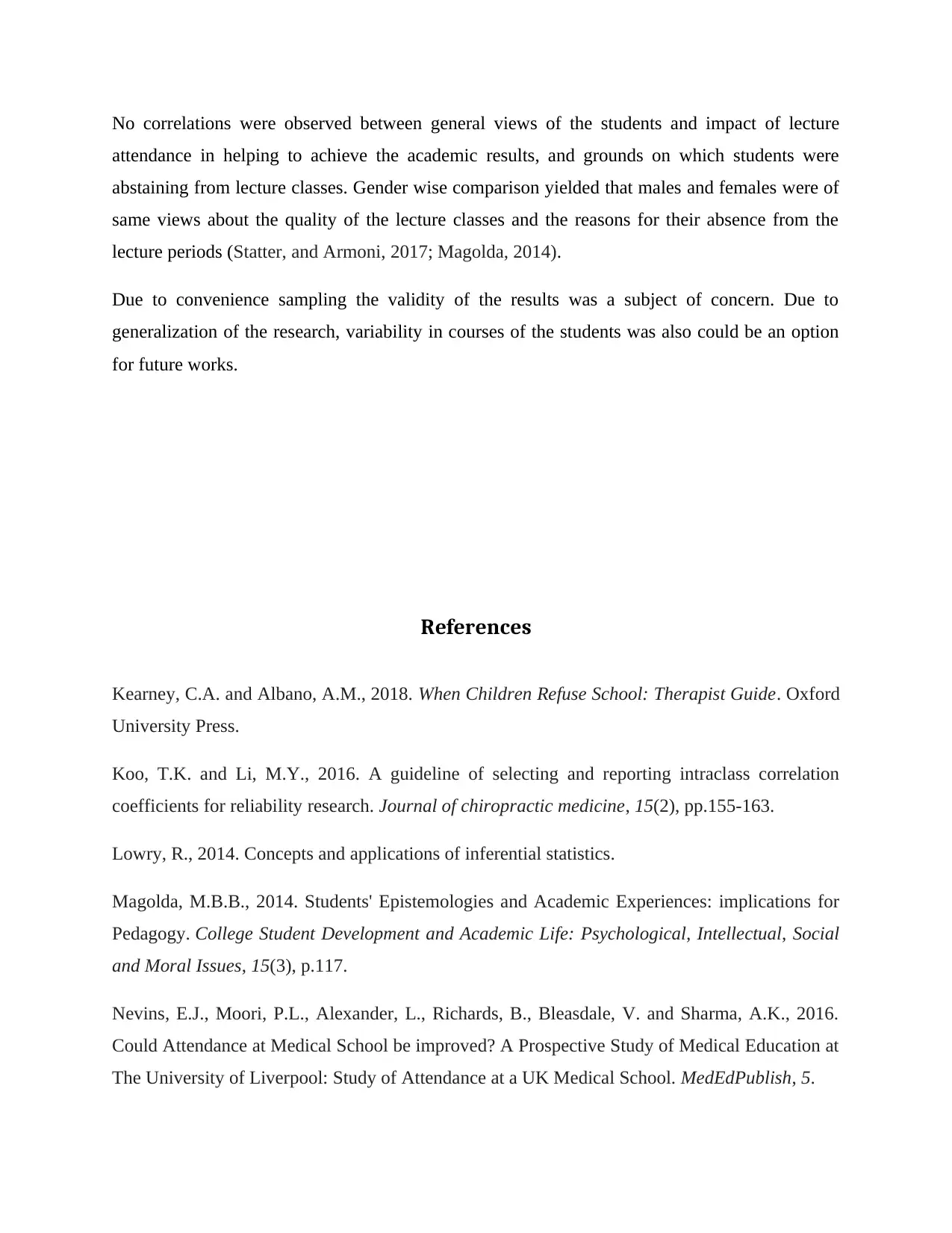
No correlations were observed between general views of the students and impact of lecture
attendance in helping to achieve the academic results, and grounds on which students were
abstaining from lecture classes. Gender wise comparison yielded that males and females were of
same views about the quality of the lecture classes and the reasons for their absence from the
lecture periods (Statter, and Armoni, 2017; Magolda, 2014).
Due to convenience sampling the validity of the results was a subject of concern. Due to
generalization of the research, variability in courses of the students was also could be an option
for future works.
References
Kearney, C.A. and Albano, A.M., 2018. When Children Refuse School: Therapist Guide. Oxford
University Press.
Koo, T.K. and Li, M.Y., 2016. A guideline of selecting and reporting intraclass correlation
coefficients for reliability research. Journal of chiropractic medicine, 15(2), pp.155-163.
Lowry, R., 2014. Concepts and applications of inferential statistics.
Magolda, M.B.B., 2014. Students' Epistemologies and Academic Experiences: implications for
Pedagogy. College Student Development and Academic Life: Psychological, Intellectual, Social
and Moral Issues, 15(3), p.117.
Nevins, E.J., Moori, P.L., Alexander, L., Richards, B., Bleasdale, V. and Sharma, A.K., 2016.
Could Attendance at Medical School be improved? A Prospective Study of Medical Education at
The University of Liverpool: Study of Attendance at a UK Medical School. MedEdPublish, 5.
attendance in helping to achieve the academic results, and grounds on which students were
abstaining from lecture classes. Gender wise comparison yielded that males and females were of
same views about the quality of the lecture classes and the reasons for their absence from the
lecture periods (Statter, and Armoni, 2017; Magolda, 2014).
Due to convenience sampling the validity of the results was a subject of concern. Due to
generalization of the research, variability in courses of the students was also could be an option
for future works.
References
Kearney, C.A. and Albano, A.M., 2018. When Children Refuse School: Therapist Guide. Oxford
University Press.
Koo, T.K. and Li, M.Y., 2016. A guideline of selecting and reporting intraclass correlation
coefficients for reliability research. Journal of chiropractic medicine, 15(2), pp.155-163.
Lowry, R., 2014. Concepts and applications of inferential statistics.
Magolda, M.B.B., 2014. Students' Epistemologies and Academic Experiences: implications for
Pedagogy. College Student Development and Academic Life: Psychological, Intellectual, Social
and Moral Issues, 15(3), p.117.
Nevins, E.J., Moori, P.L., Alexander, L., Richards, B., Bleasdale, V. and Sharma, A.K., 2016.
Could Attendance at Medical School be improved? A Prospective Study of Medical Education at
The University of Liverpool: Study of Attendance at a UK Medical School. MedEdPublish, 5.
Secure Best Marks with AI Grader
Need help grading? Try our AI Grader for instant feedback on your assignments.
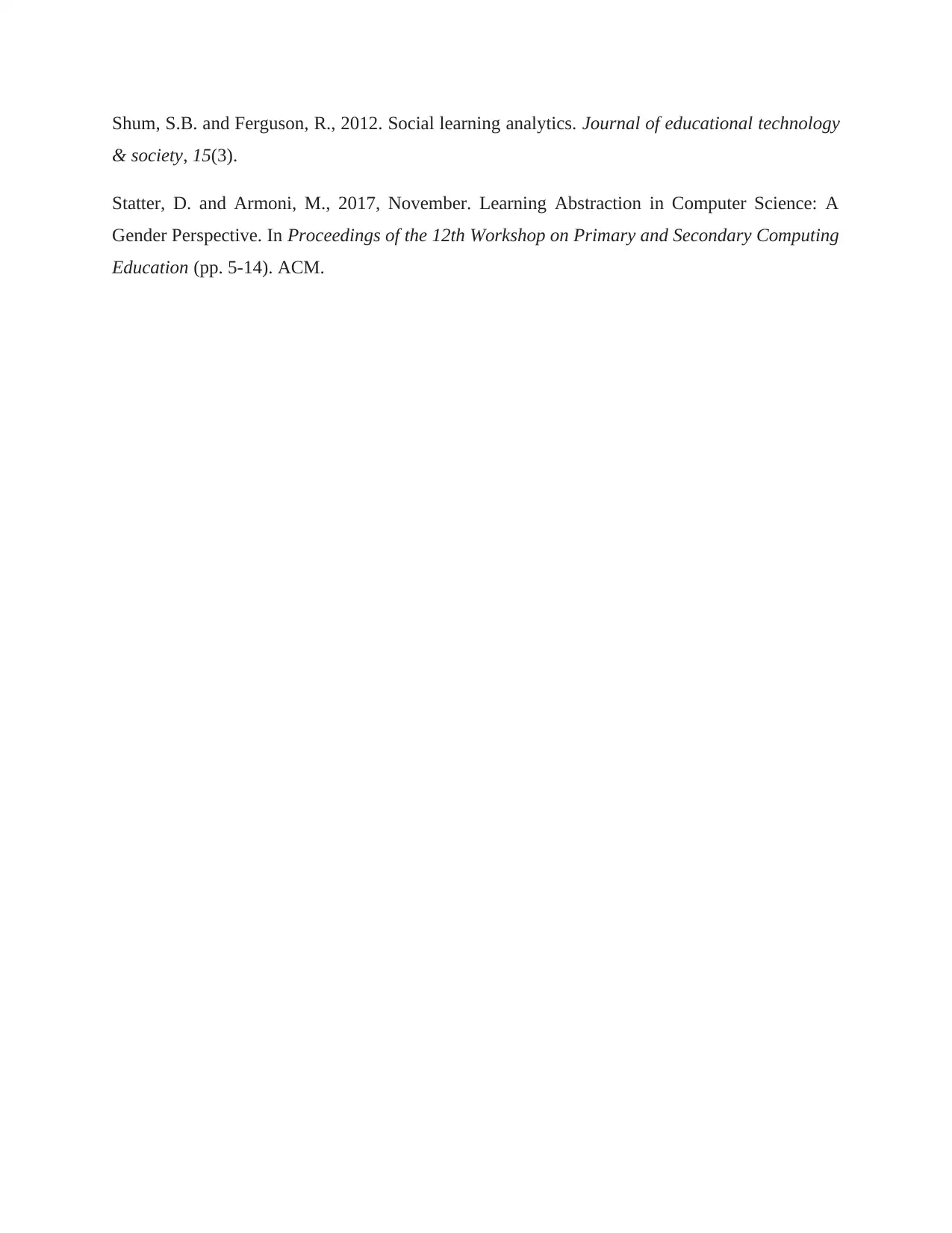
Shum, S.B. and Ferguson, R., 2012. Social learning analytics. Journal of educational technology
& society, 15(3).
Statter, D. and Armoni, M., 2017, November. Learning Abstraction in Computer Science: A
Gender Perspective. In Proceedings of the 12th Workshop on Primary and Secondary Computing
Education (pp. 5-14). ACM.
& society, 15(3).
Statter, D. and Armoni, M., 2017, November. Learning Abstraction in Computer Science: A
Gender Perspective. In Proceedings of the 12th Workshop on Primary and Secondary Computing
Education (pp. 5-14). ACM.
1 out of 23
Related Documents
Your All-in-One AI-Powered Toolkit for Academic Success.
+13062052269
info@desklib.com
Available 24*7 on WhatsApp / Email
![[object Object]](/_next/static/media/star-bottom.7253800d.svg)
Unlock your academic potential
© 2024 | Zucol Services PVT LTD | All rights reserved.


